We slept in the morning of the 25th, exhausted from back-to-back big days, and headed to a coffee shop to figure out our next moves. To our frustration the weather in the PNW still looked terrible for the next week. With our dreams of Cascade skiing looking more and more unlikely we wracked our brains for other options. On a whim we checked the Chugach forecast. Sun. At first the idea seemed fanciful, but realizing that we still had Alaska Airline credit from our canceled trip earlier in the spring, we started to look at flights. Last minute flights were surprisingly reasonable so we bought tickets for the following afternoon from Seattle. Motivated by the sudden appearance of a plan we hopped in the car and started the 6 hour drive to Seattle.
Gabe and Liza graciously offered to let us store our van at their house so we set our sights there. We arrived in the late evening (not before squeezing in yet another activity) and they watched with amusement as we attempted to move all of our gear from the van into travel bags for the flight. The following afternoon we found ourselves at the Seattle airport, and by the evening of the 26th Taryn’s mom was picking us up from the Anchorage airport.
Our original plan was to spend a week or two skiing in the Chugach, but when we checked the weather the morning of the 27th we saw that the forecast had warmed dramatically. With the first warm-spell of the spring arriving in just a day or two there was a real risk that the “spring shed” (widespread avalanching as the snowpack transitions from winter to spring) might shut us down. We decided to prioritize our top goal, the Eklutna Traverse, a beautiful 40 mile traverse through the heart of the western Chugach. In order to attempt to beat the warming weather we decided to leave that afternoon, hoping the leverage the long spring days to get a jump on approach.
We spent a few crazy hours grocery shopping, organizing gear, and figuring out car shuttle logistics. By early afternoon our backpacks were packed so we threw our bags and skis into the car and headed to the Eklutna Lake Trailhead.
Arriving at the trailhead we were disappointed to see blue water through the trees. The Eklutna traverse starts with a long flat approach to the nose of the Eklutna Glacier. In ideal conditions the lake will be frozen, making it possible to skate across the lake. This approach saves two miles and is considerably quicker. Unfortunately the lake was almost entirely thawed meaning we would have to make the monotonous walk around the lake. We strapped our skis to our already heavy packs and set off on our adventure.
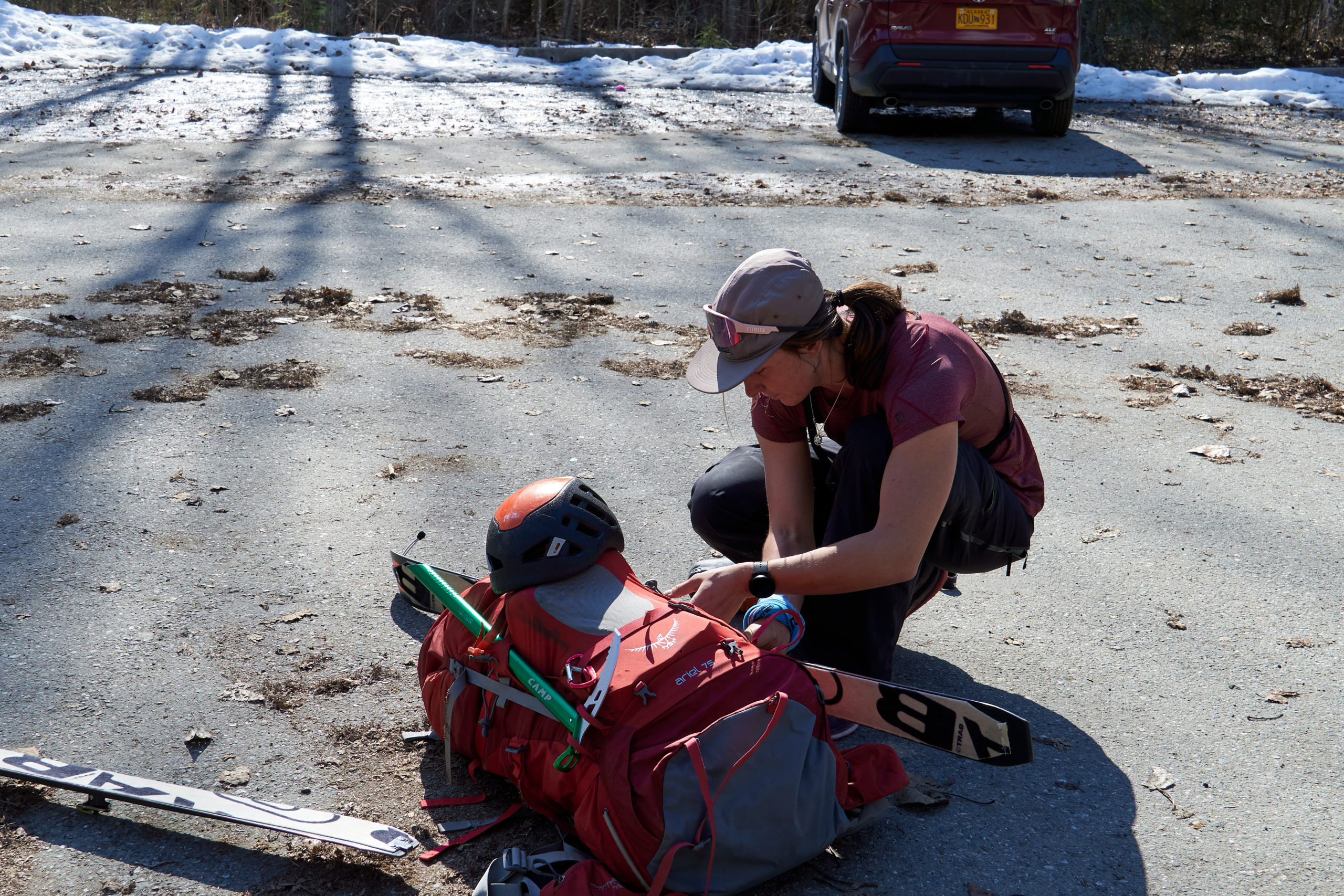
Hiking along the gravel road may have been less exciting than skating across the lake, but the smooth road made for easy travel and we soon settled into a steady rhythm.
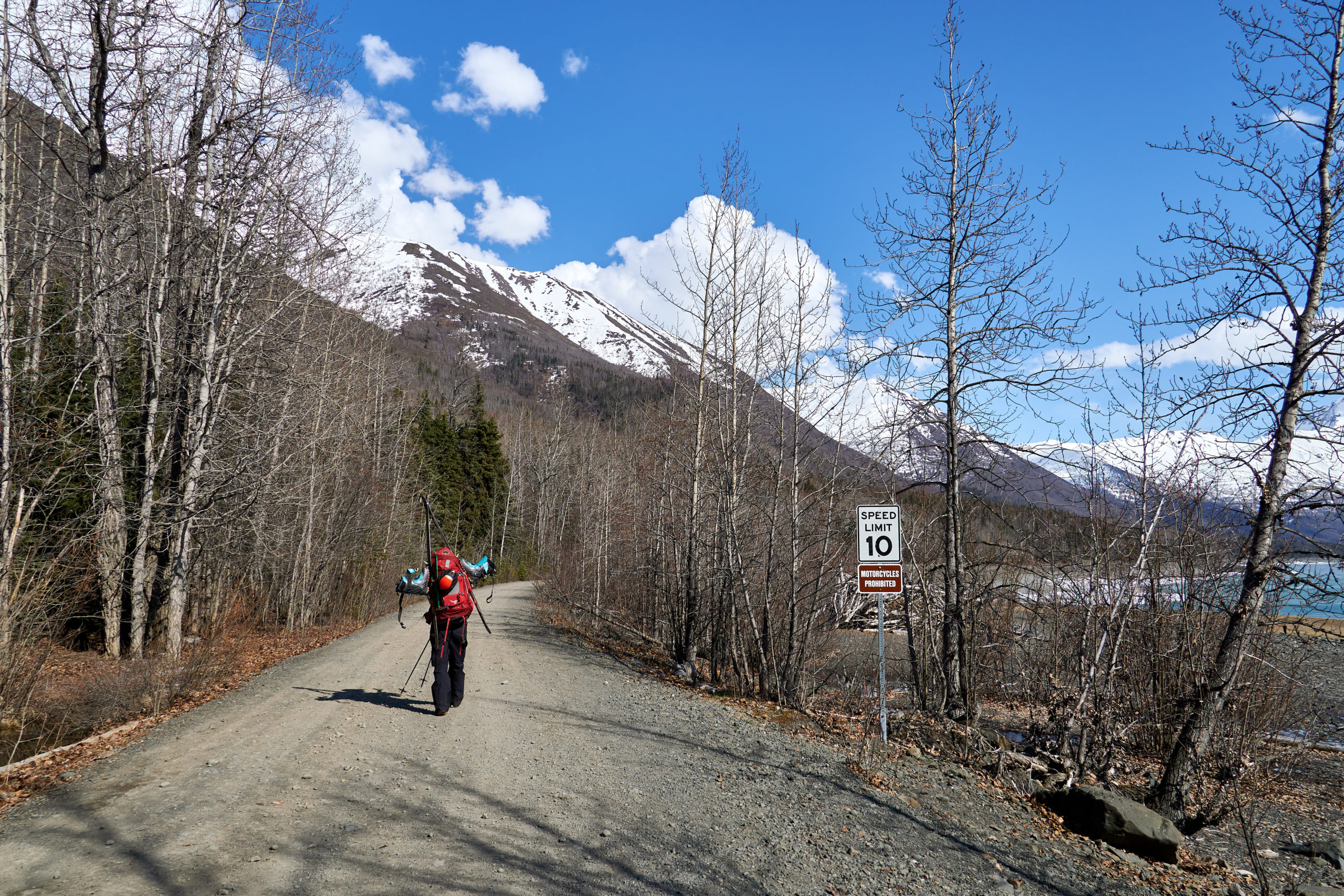
Shortly after leaving the trailhead we ran into a group of three skiers who were on their way out, having bailed deep into the traverse. They reported no overnight refreezes, leading to dangerous avy conditions. They laughed when we informed them we were headed in for the traverse, but politely held off discouraging us too much when they saw Taryn and I were still considering going for the traverse.
After they left us Taryn and I talked briefly about their report but both quickly agreed to continue on the mission. The upcoming night was supposed to be a bit cooler and it wasn’t clear what else we would do if we bailed on the traverse since it seemed like there was only a day or two remaining before it was definitely too warm to ski anything. Having justified the decision to keep going with a healthy mix of logic and desperation we hoisted our backs and continued around the lake.
The mountains grew more and more dramatic as we wrapped around the lake, their jagged peaks perfectly contrasting the seemingly never ending road ahead of us.
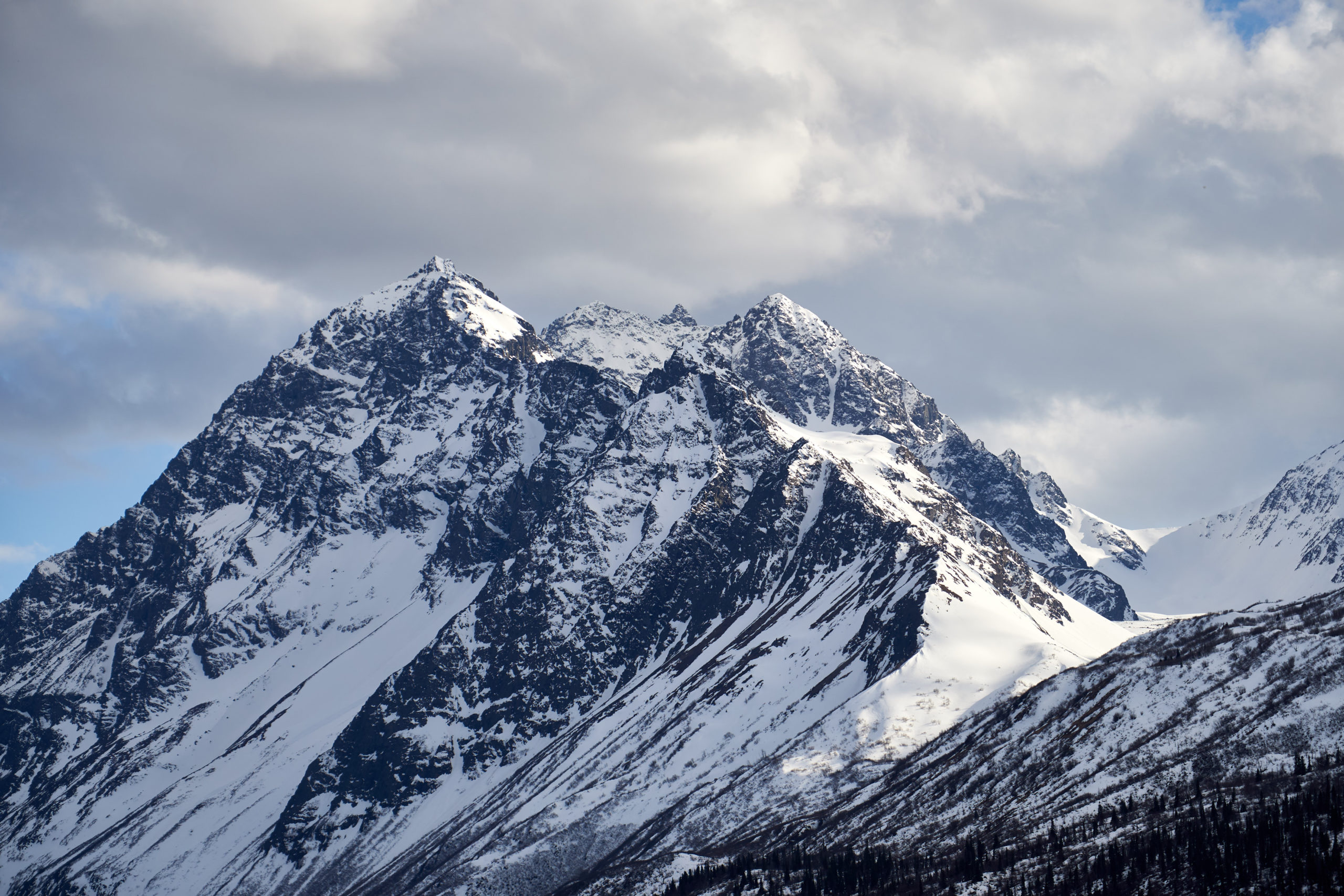
Two and a half hours (and eight miles) later we finally reached the other end of the lake. We took our packs off to rest our sore shoulders and admire the grandeur of Alaska. Growing up in Massachusetts the contrast between Alaska’s state parks and Massachusetts’ never ceases to amuse me. Nothing against Bradley Palmer State Park of course, but I think I’ll choose the Chugach any day of the week.

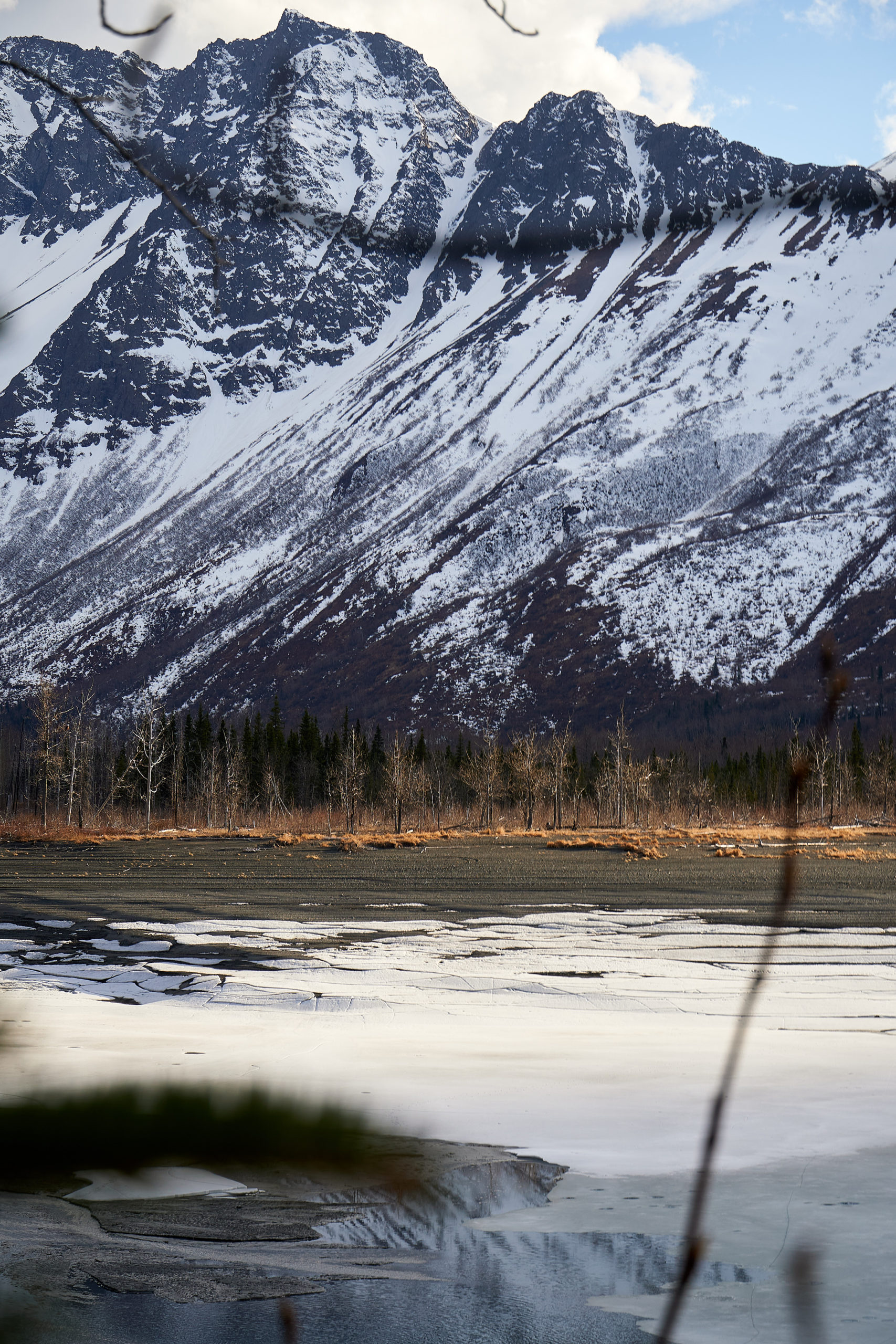

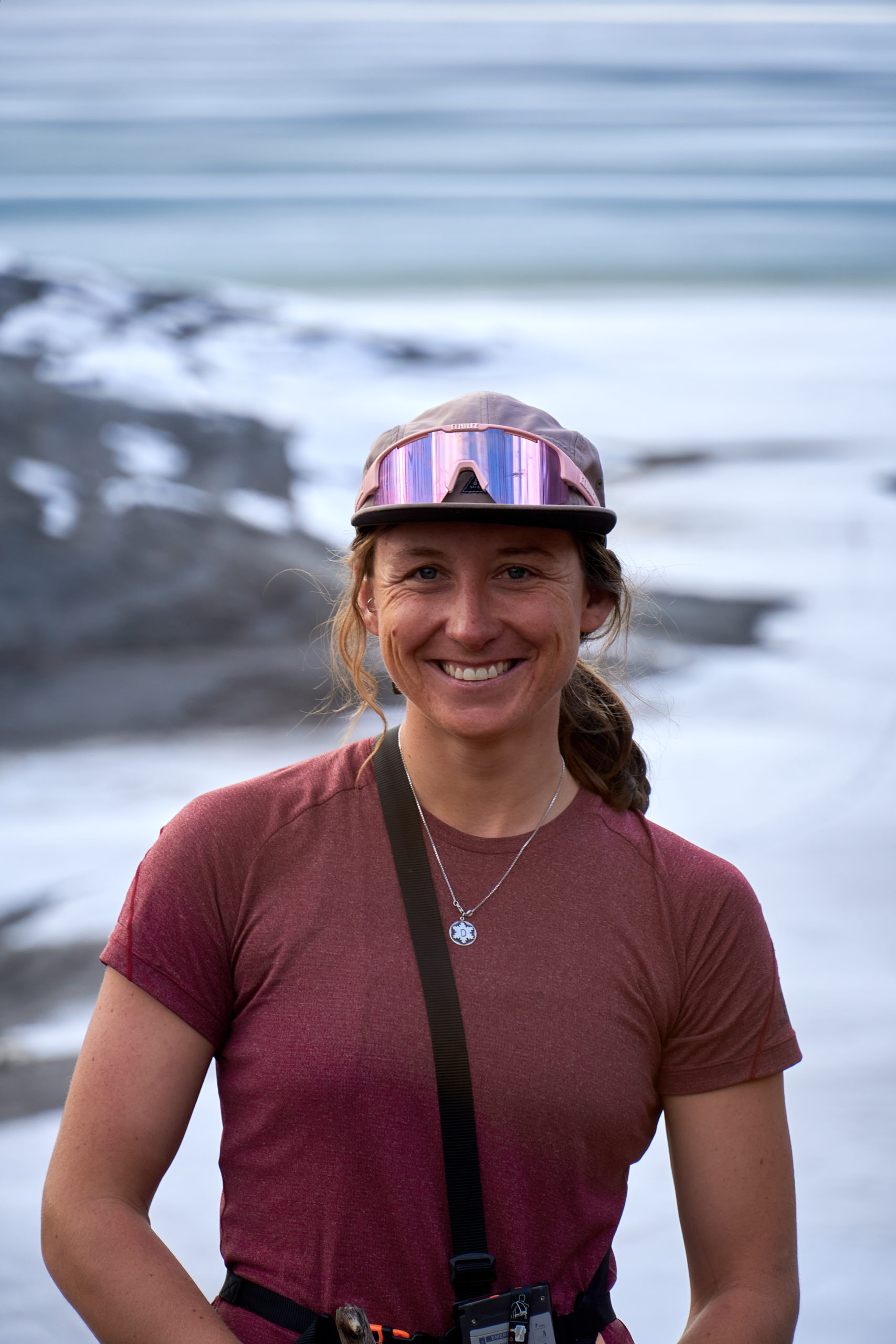
We attempted to procrastinate on finishing the hike with a photo shoot and lots of snacking, but we still had a long way to go to our destination for the night, Serenity Falls Hut, so we hoisted our heavy packs and continued walking. It was now 6:30pm and the idea of being out in the marshy brush with a bunch of hungry bears when the sun eventually did set did not sound appealing.
We arrived at Serenity Falls Hut around 8:30. To our joy it was empty. Unlike the other shelters along the route, Serenity Falls is reservable and had been marked as reserved when we had checked earlier in the day. As a backup plan we carried a small two person tent (which would go unused all trip), but the aforementioned bears and cold night had us very excited to be sleeping indoors. We got a fire going and settled in to make some well deserved dinner.
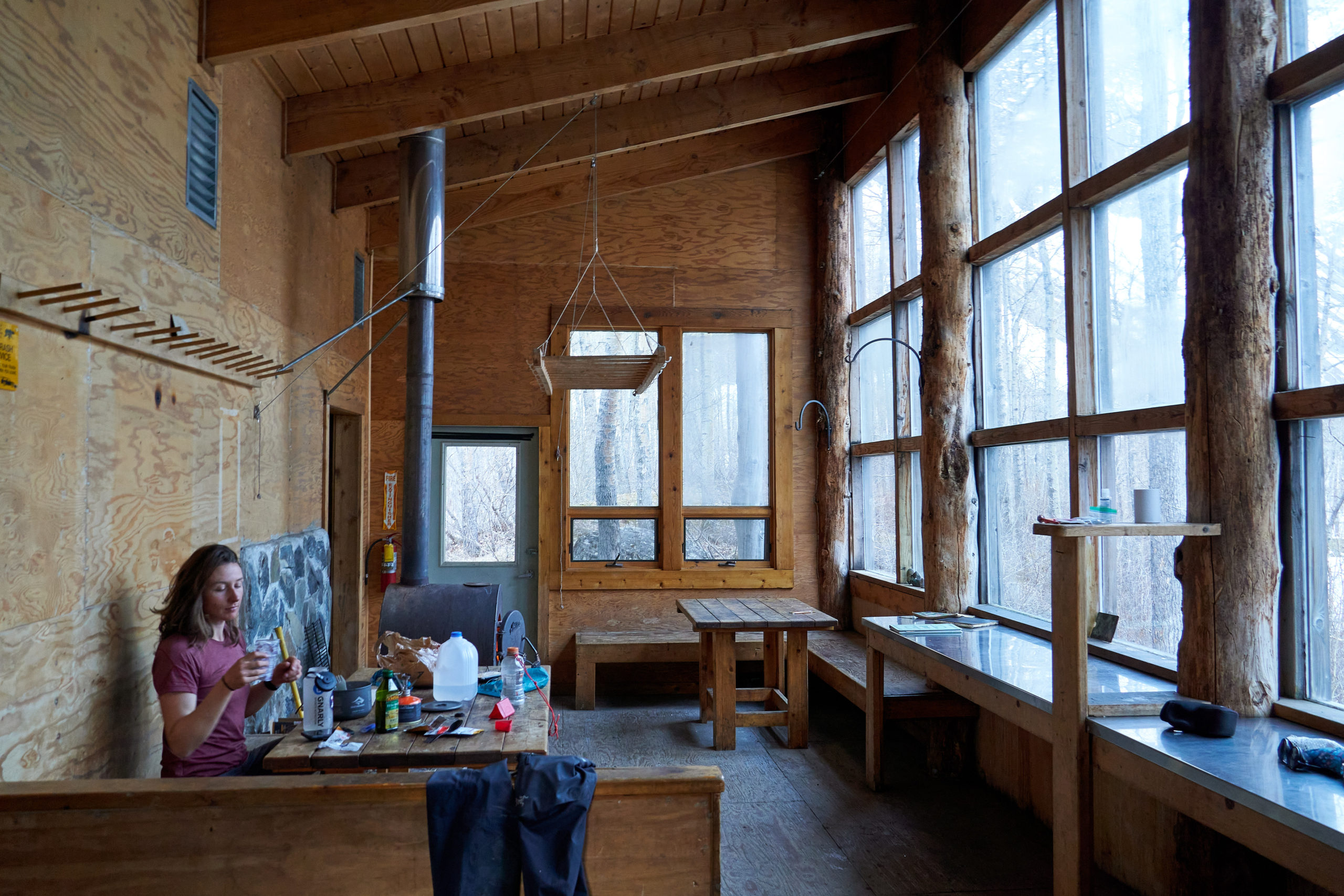
The large windows on the south side of the hut offered both an exciting and intimidating preview of the next day’s adventure, the valley walls quickly pinching down to obscure the terrain ahead, only a few snow-capped peaks visible beyond. We did our best to ignore any nerves about what lay ahead and crawled into our sleeping bags for a much needed night of rest.
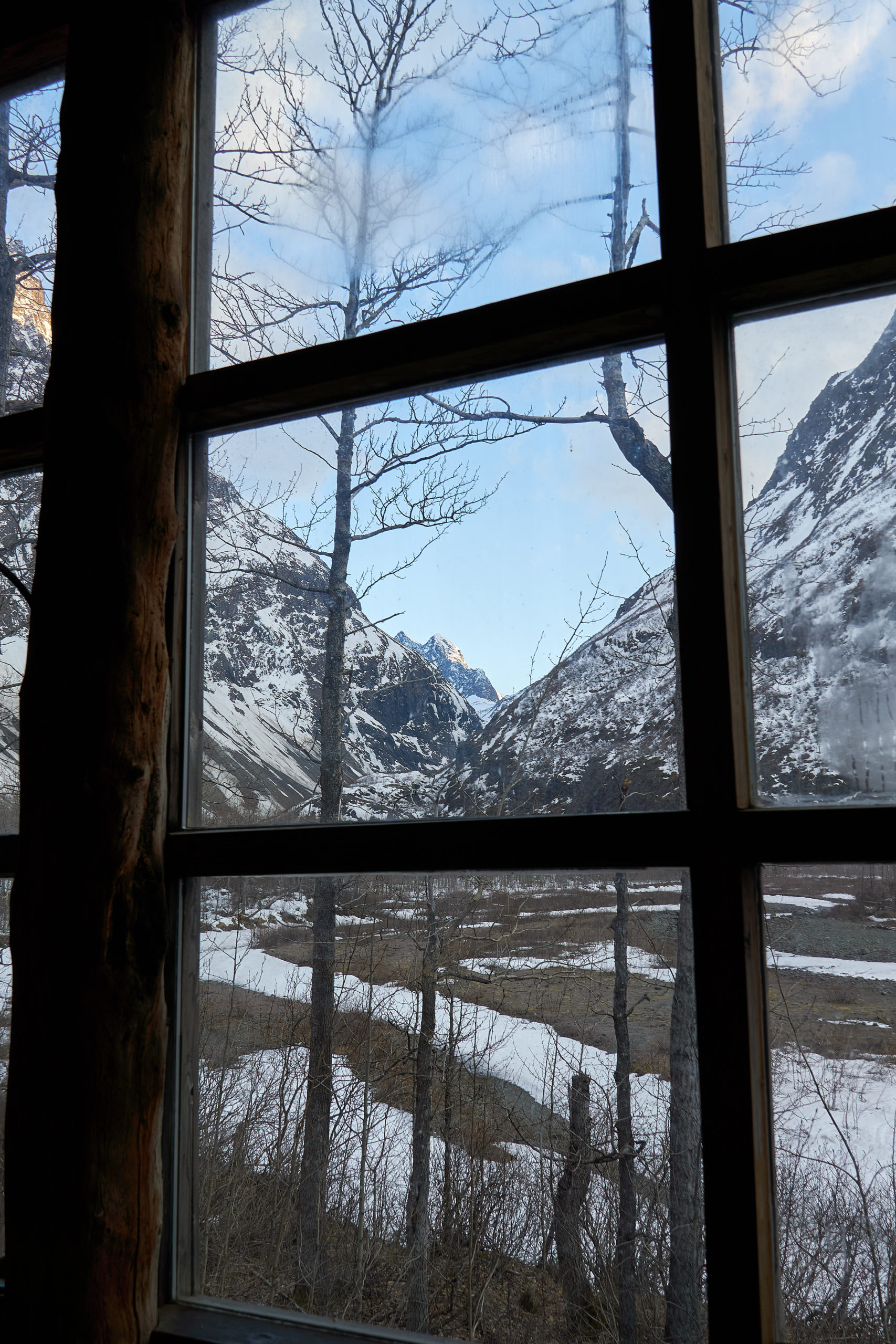
We were up and moving by 6:45am the next morning. After about a mile of easy walking we reached the end of the established trail. From there the travel slowed into a combination of slide alder, unsupportable snow, and talus. The tedious mixture forced us to repeatedly transition from walking to skiing and back.
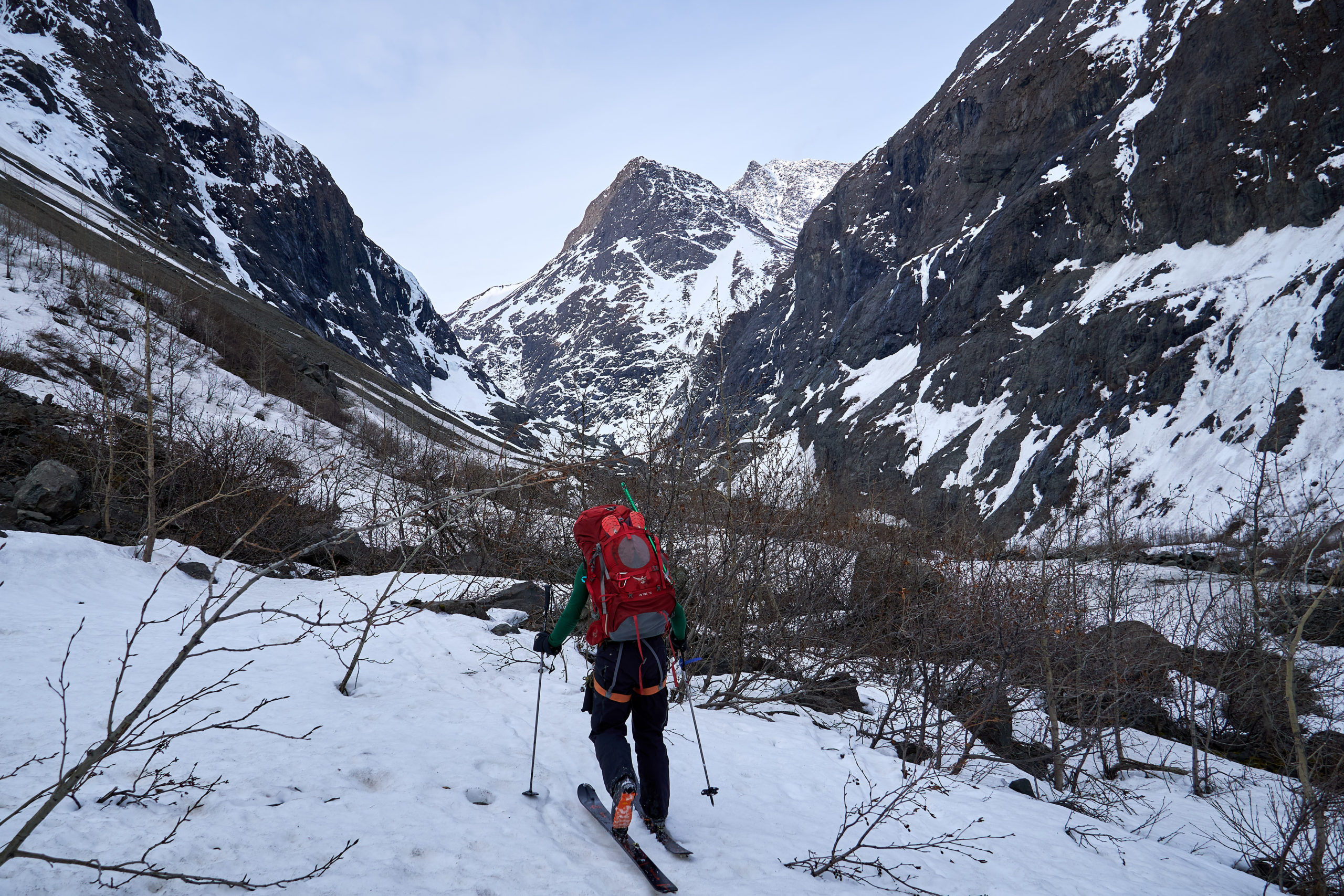
After almost two hours of work, and having covered less than 4 miles, we finally found ourselves on consistent snow. As we rounded a corner we got our first view of the terrain leading up to Eklutna Glacier. We had read that getting onto the glacier can be one of the cruxes of the traverse, necessitating careful route finding and potentially requiring difficult rock scrambling if the snow is too melted out. To our relief it appeared as if there was a reasonable passage up some steep snow slopes and lower angle rock bands to the left of the main drainage. Some faint skin tracks from the previous travelers indicated that the route did indeed go. The terrain that must be navigated can be seen in the photo below (with the skin track just visible).

Our route up to the glacier went smoothly, with only a few tricky transitions from snow to rock. I can definitely imagine it being tricky though if the snow was more melted out.
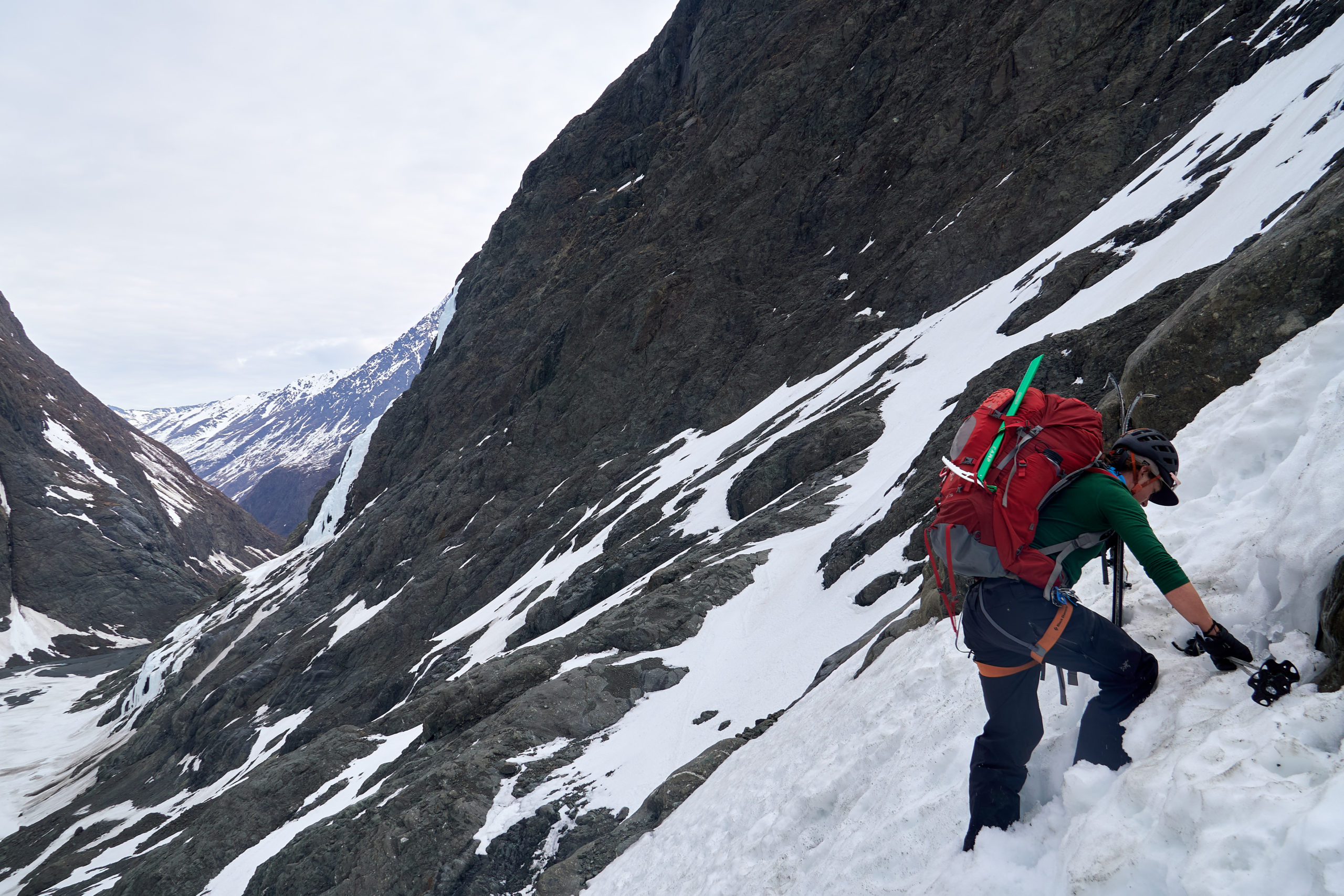
Arriving at the top of the bench at the toe of the glacier we stopped to to pull out the rope. Even though the glacier looked solid with minimal signs of crevasses, we opted to rope up for all of the ascending on glaciers throughout the trip just to be safe. With no other contact with humans since our run in near the trailhead we definitely felt pretty far out there and didn’t want to leave anything to chance.
Travel on the glacier was wonderfully efficient. The snow had clearly refrozen the night before and wide open snow was a welcome change from the brush below. Below is the view looking back towards Eklutna Lake shortly after getting on the glacier. Definitely some overhead hazard earlier in the season, but now just bare rocks and soil (a fact we would become very thankful for later).
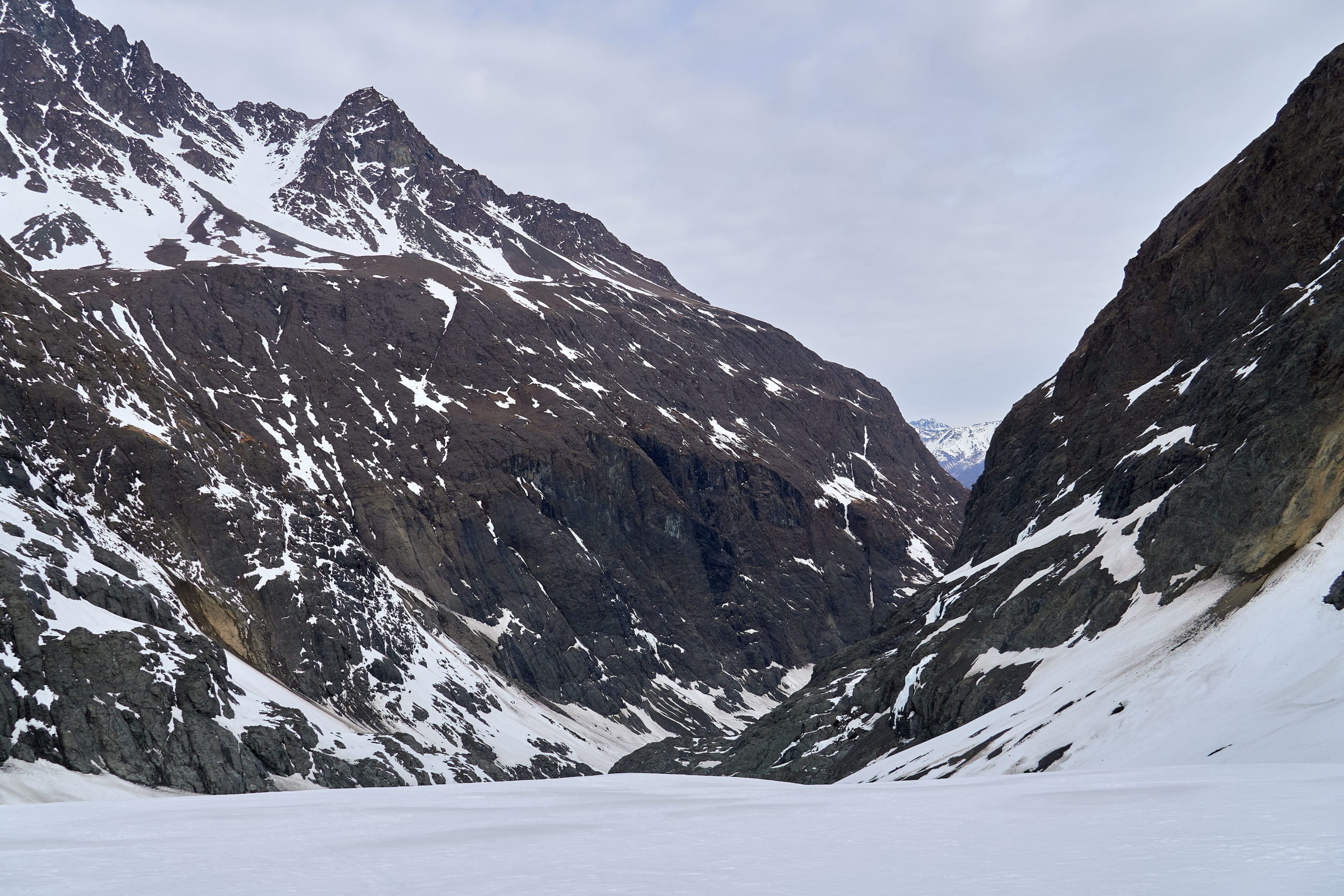
Taryn lead the way through some beautiful exposed glacial ice, with the impressive Peril Peak in the background.
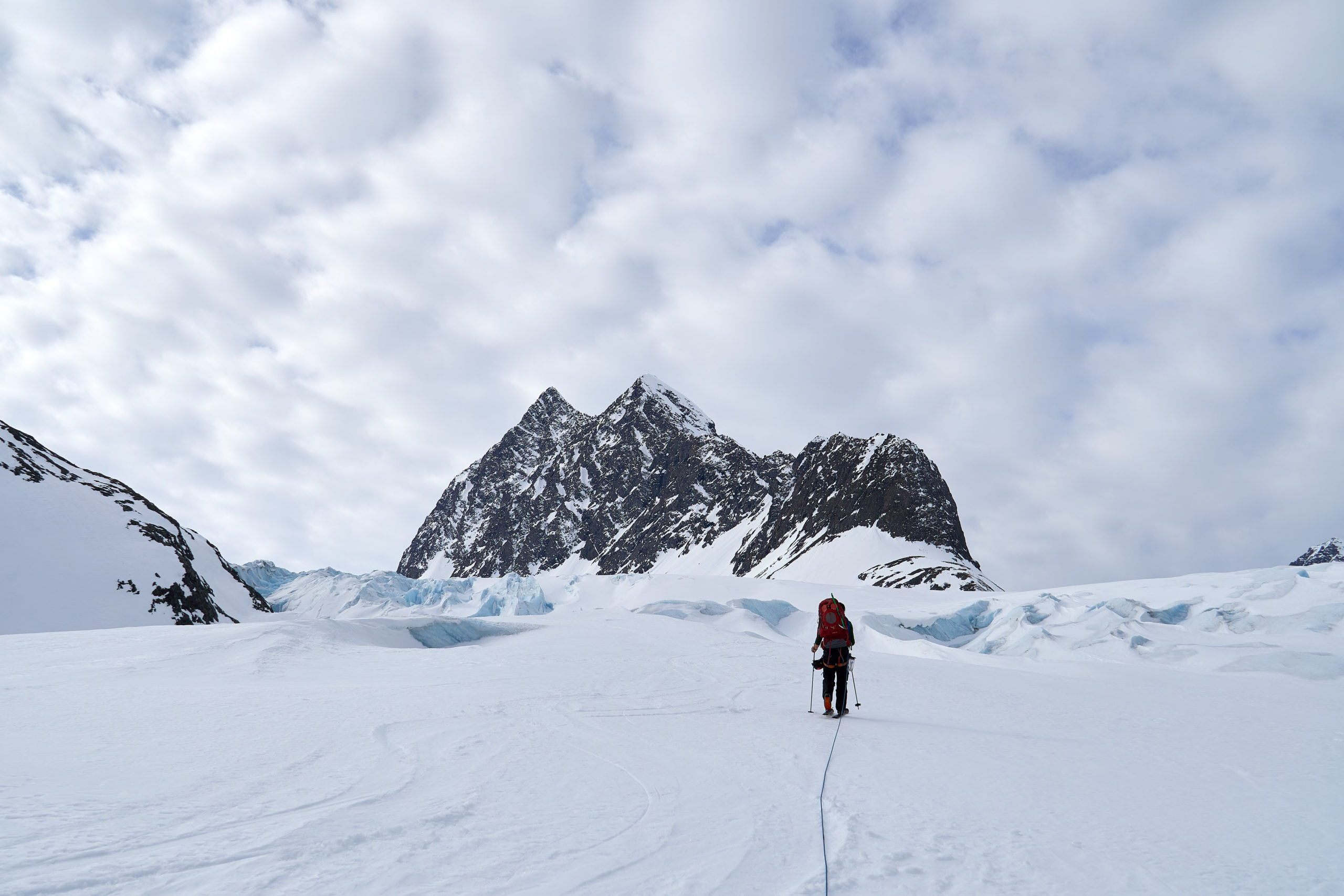
After about two and a half miles on the glacier we got our first view of Pichler’s Perch, the first in a series of huts along the traverse. We knew that two more such huts lay ahead of us on the route, Han’s Hut and Rosie’s Roost, the later of which was our intended destination for the day.
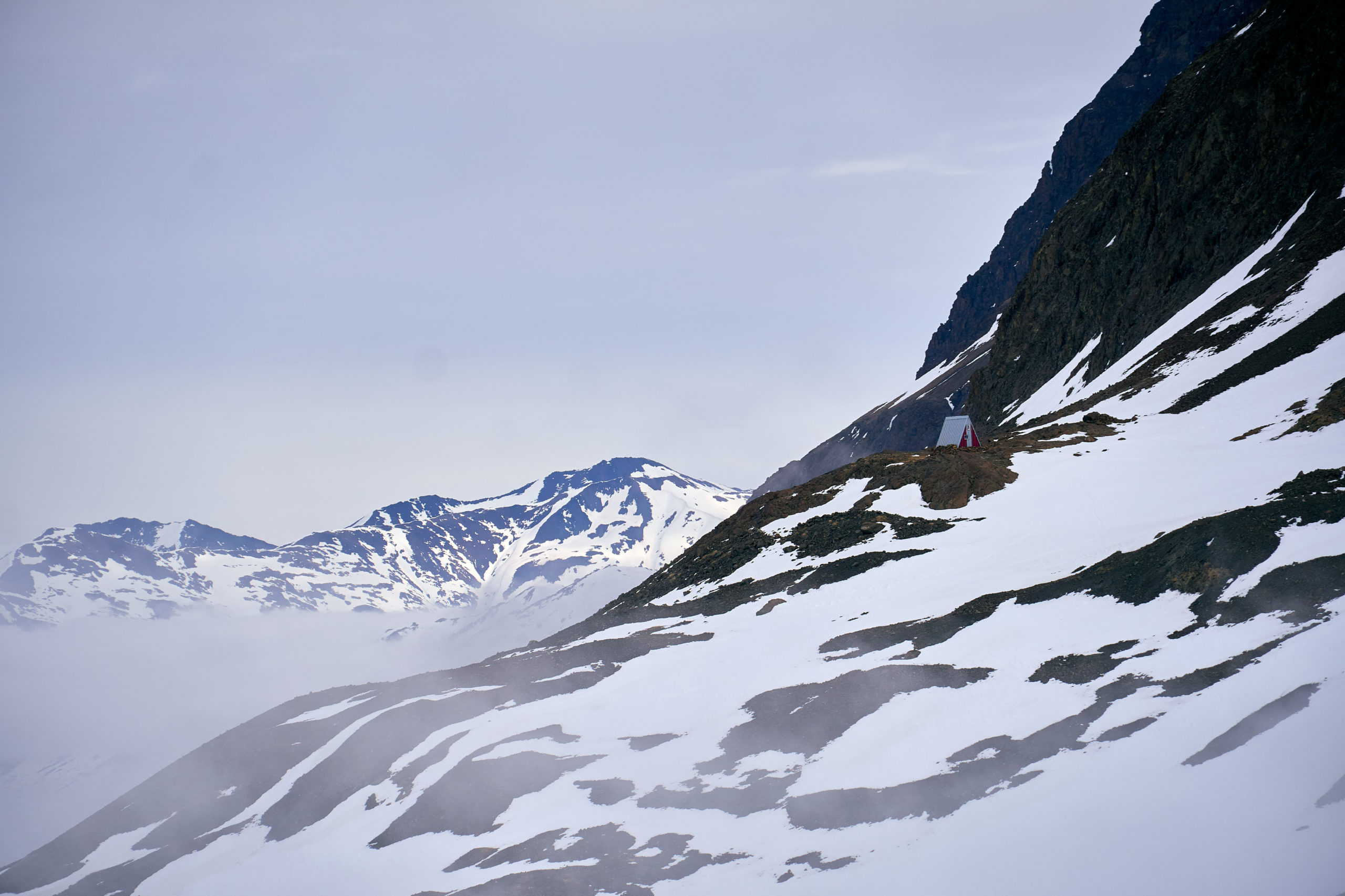
As we progressed higher up Eklutna Glacier the angle flattened and the glacier widened until it felt like we were walking across an ice field. Apart from occasional map checks to make sure we were headed in the right direction there wasn’t much to do except soak up the views and keep putting one foot in front of the other. Our target at the end of the glacier, Whiteout Pass, is just visible on the horizon to Taryn’s right in the photo below.
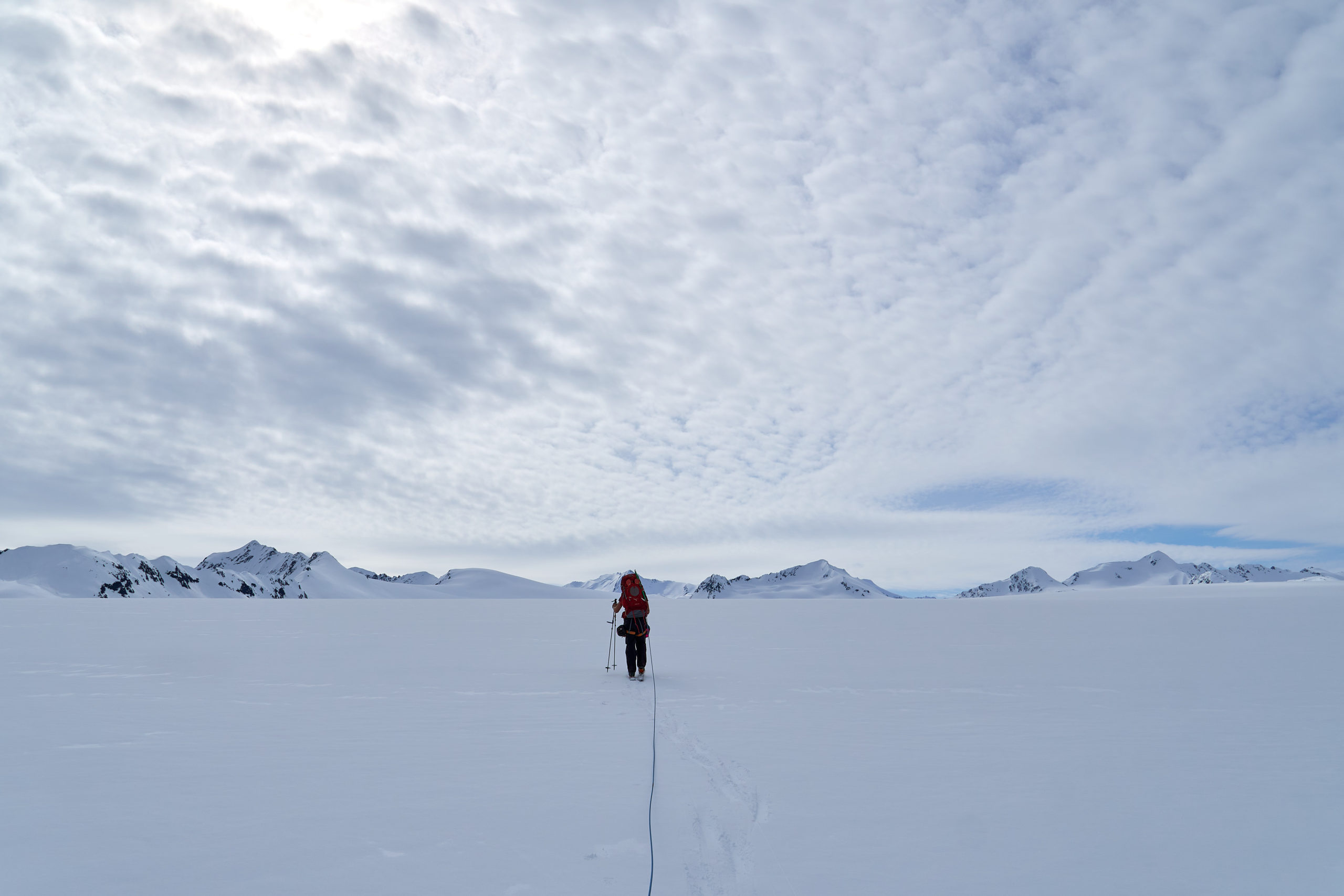
One of the only markers of progress as we inched across the massive glacier was a wall of low lying clouds that worked its way up the glacier behind us. It was fun to watch the clouds envelope our tracks behind us, a race of two types of tortoises towards the end of the glacier.
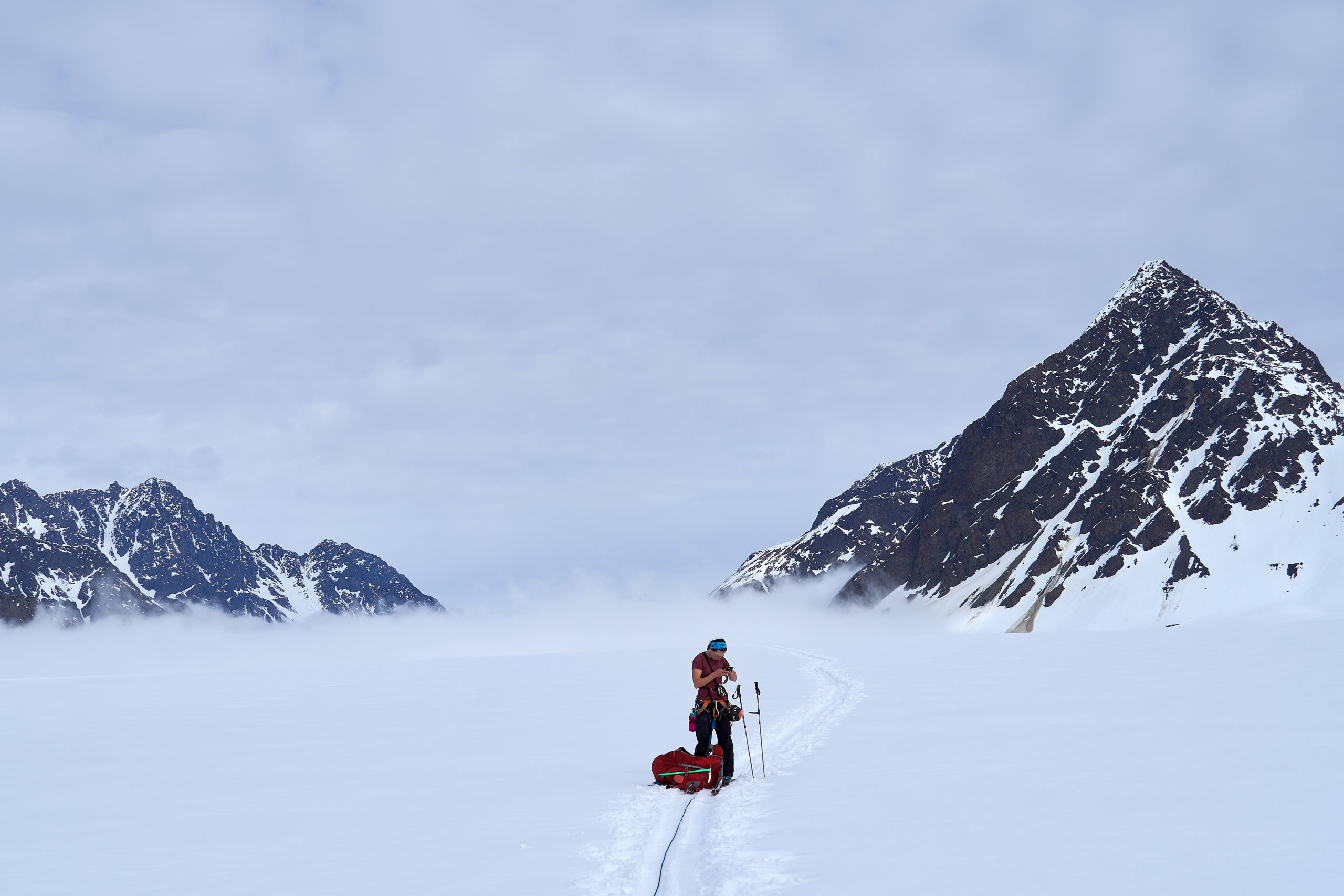
Three hours and seven miles after stepping onto the glacier we reached Whiteout Pass, the divide between Eklutna and Whiteout glacier. Although the terrain had felt almost entirely flat while skinning, it was satisfying to look back down the valley from where we had come, realizing we were now truly in a remote alpine environment.
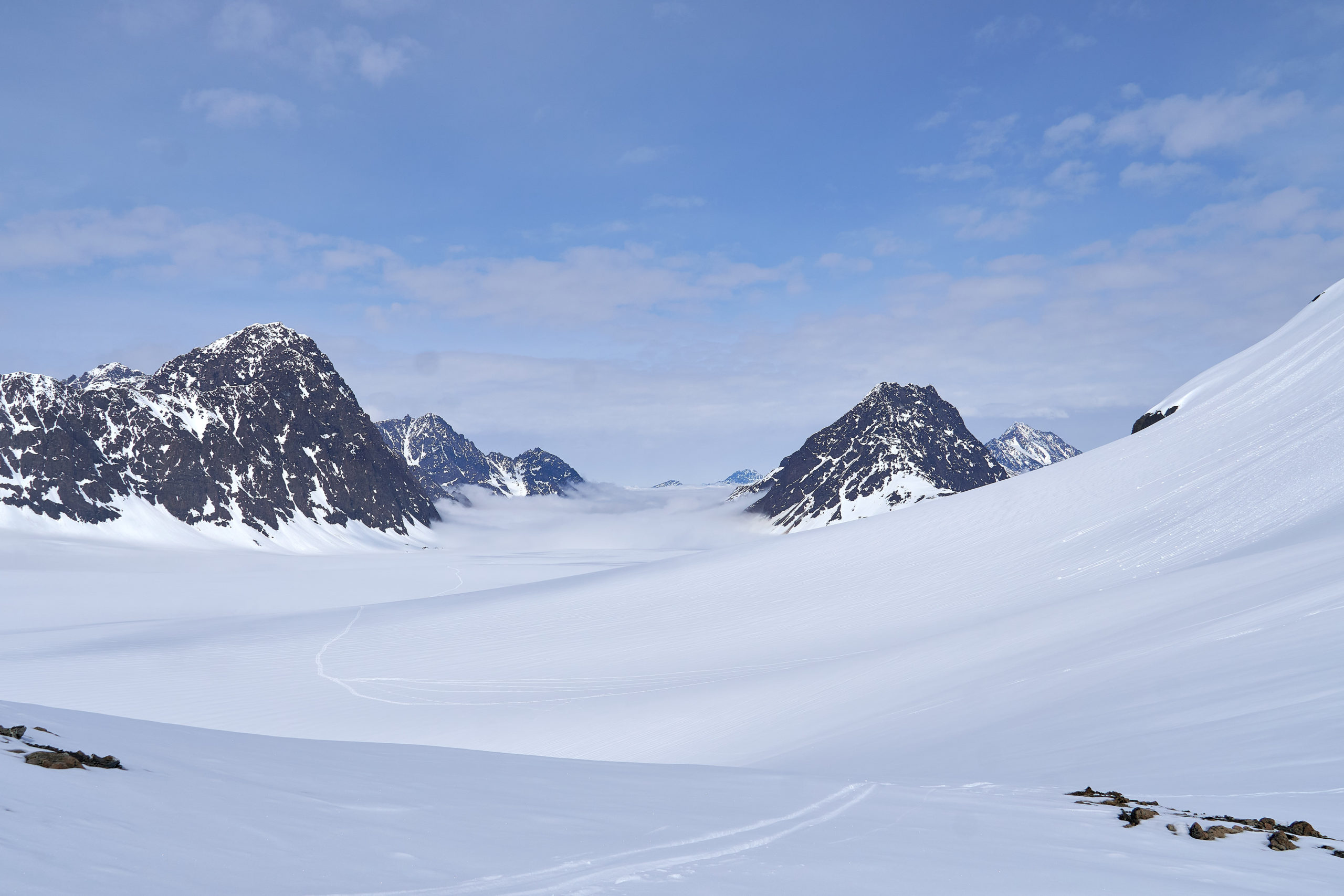
Looking ahead, Whiteout Glacier looked equally expansive with a namesake-worthy layer of clouds engulfing much of it.
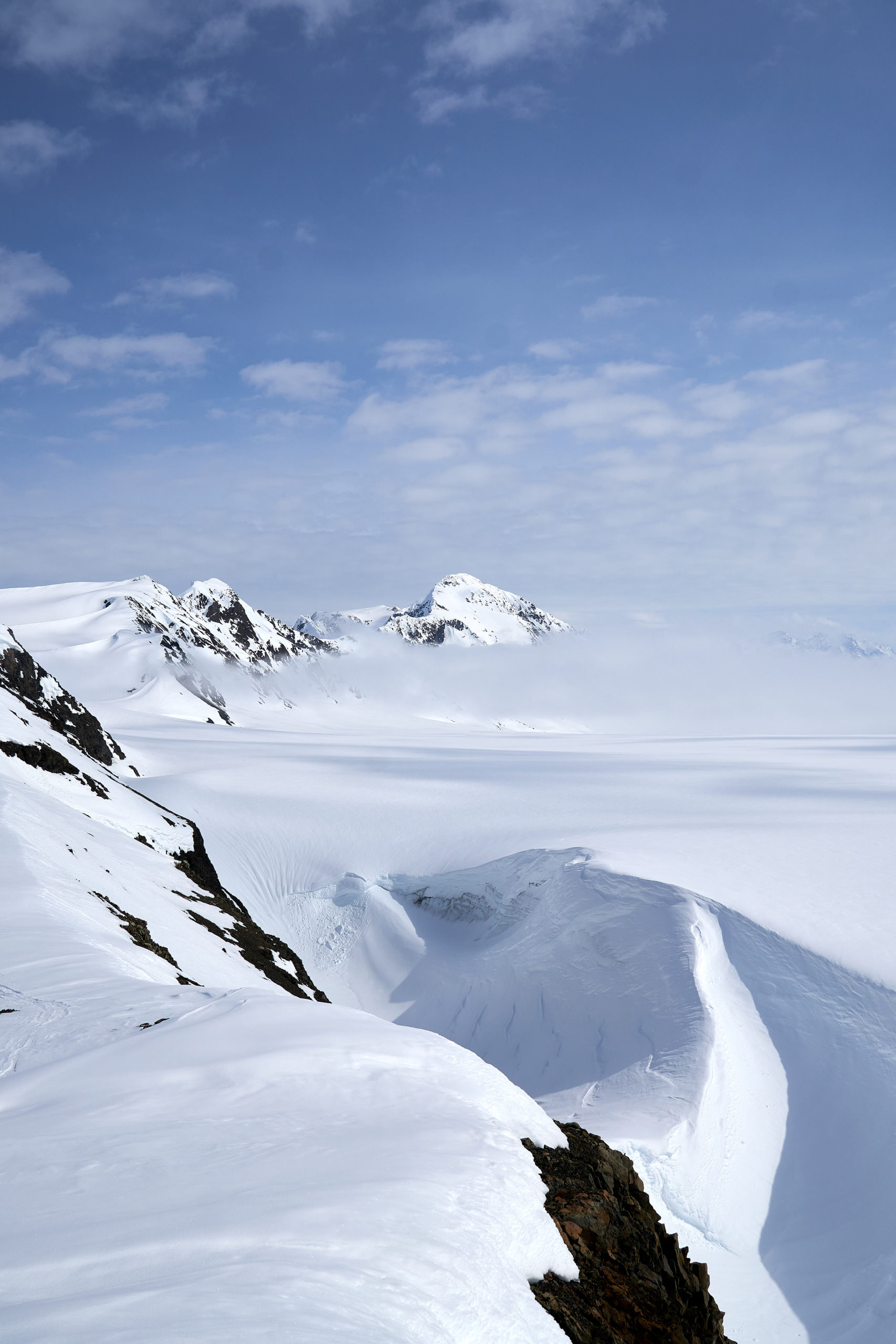
In the far distance we were able to spy Hut Peak and the second hut, Han’s Hut tucked beneath it. A faint skin track descended from Whiteout Pass and wound its way towards the hut.
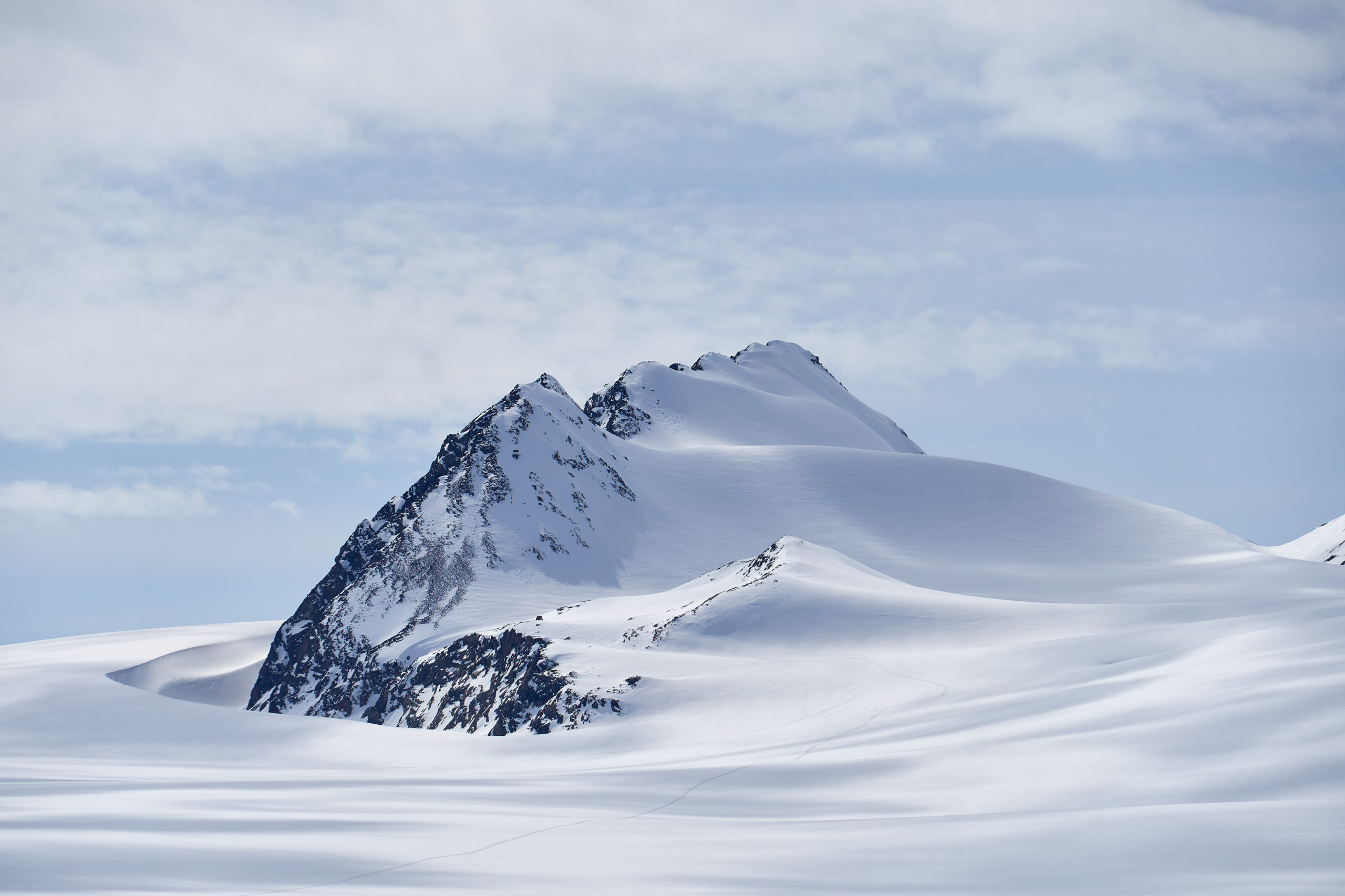
After some lunch at the pass we descended down onto Whiteout Glacier and started along the skin track. It was not before the clouds we had observed blew in and engulfed us. The existence of the skin track was a godsend because immediately it felt like we were inside a ping pong ball. The green-housing with the thin layer of clouds was some of the most extreme I’ve experienced and we found ourselves stopping for quick breaks to cool off as the temperature and humidity soared.

Eventually we felt ourselves climbing and the fog grew thinner and thinner until we popped out on the slope up to Han’s Hut, finally able to get our bearings.
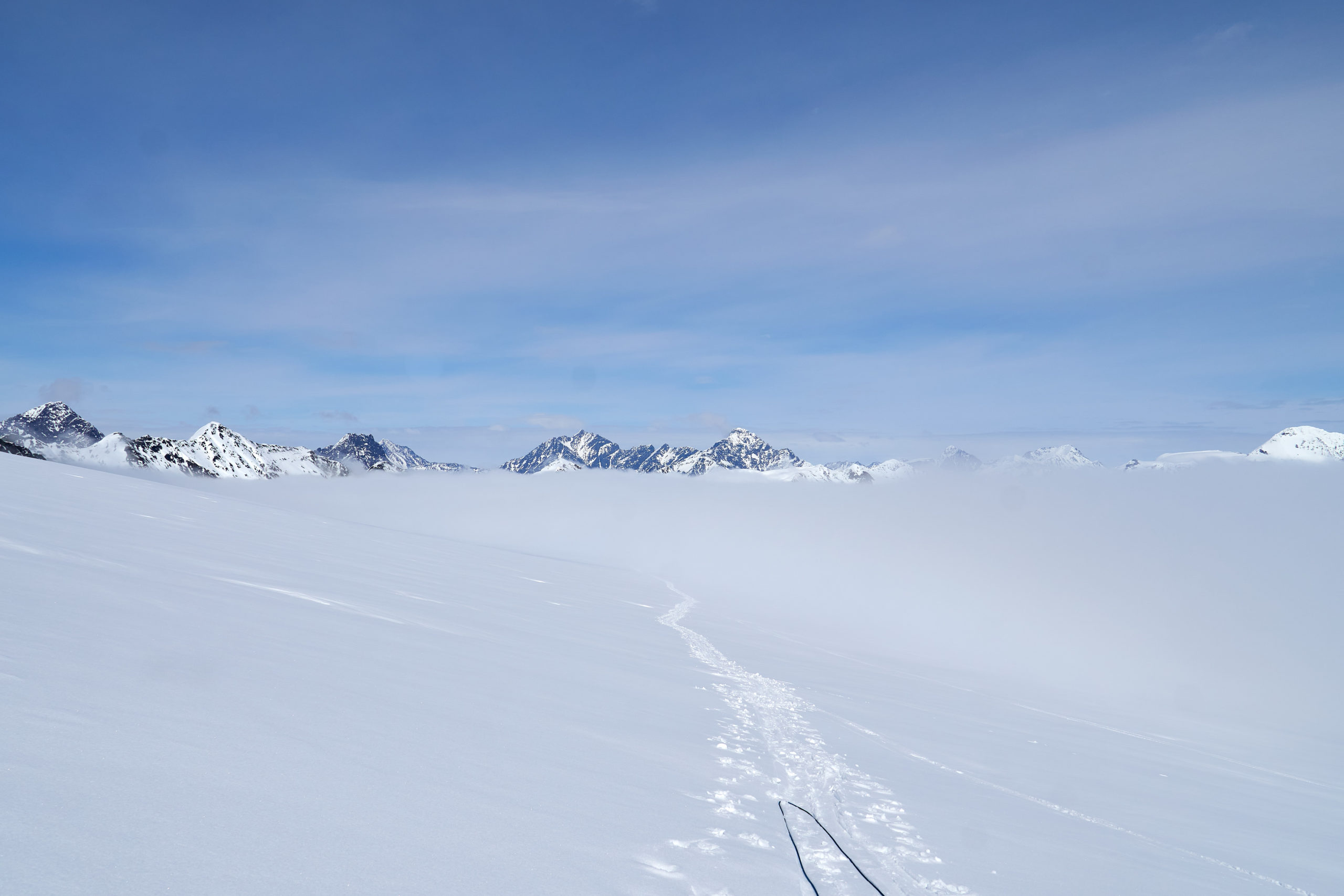
A fork in the skin track continued south along Whiteout Glacier towards Eagle Glacier so we took that track and descended back down into the clouds. A bit more walking and we again emerged from the whiteout.
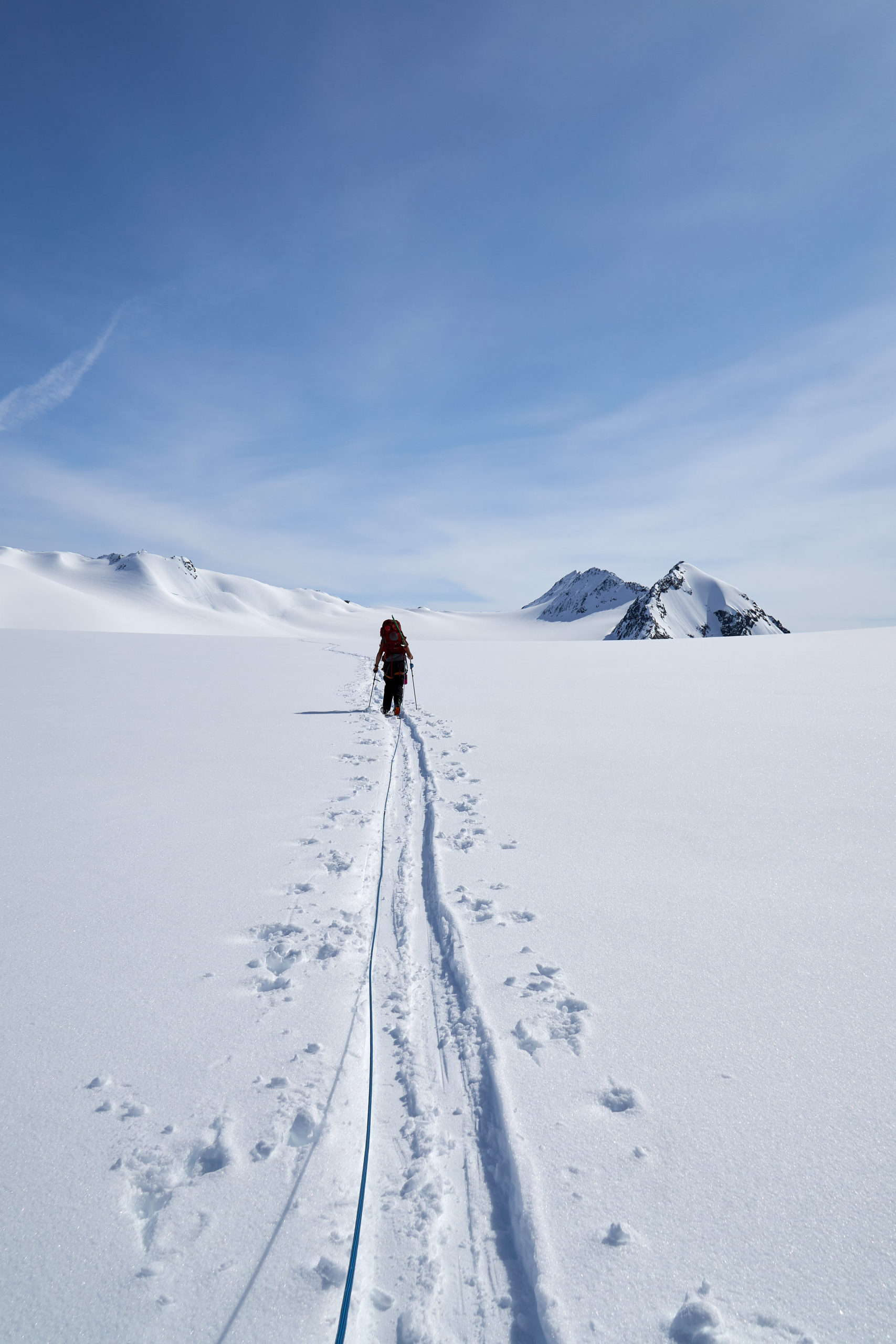
Eventually the ground began to gradually slope downwards and soon we crested a rollover and got our first views of Eagle Glacier with Raven Peak (and our exit over Raven Headwall) lurking behind it.
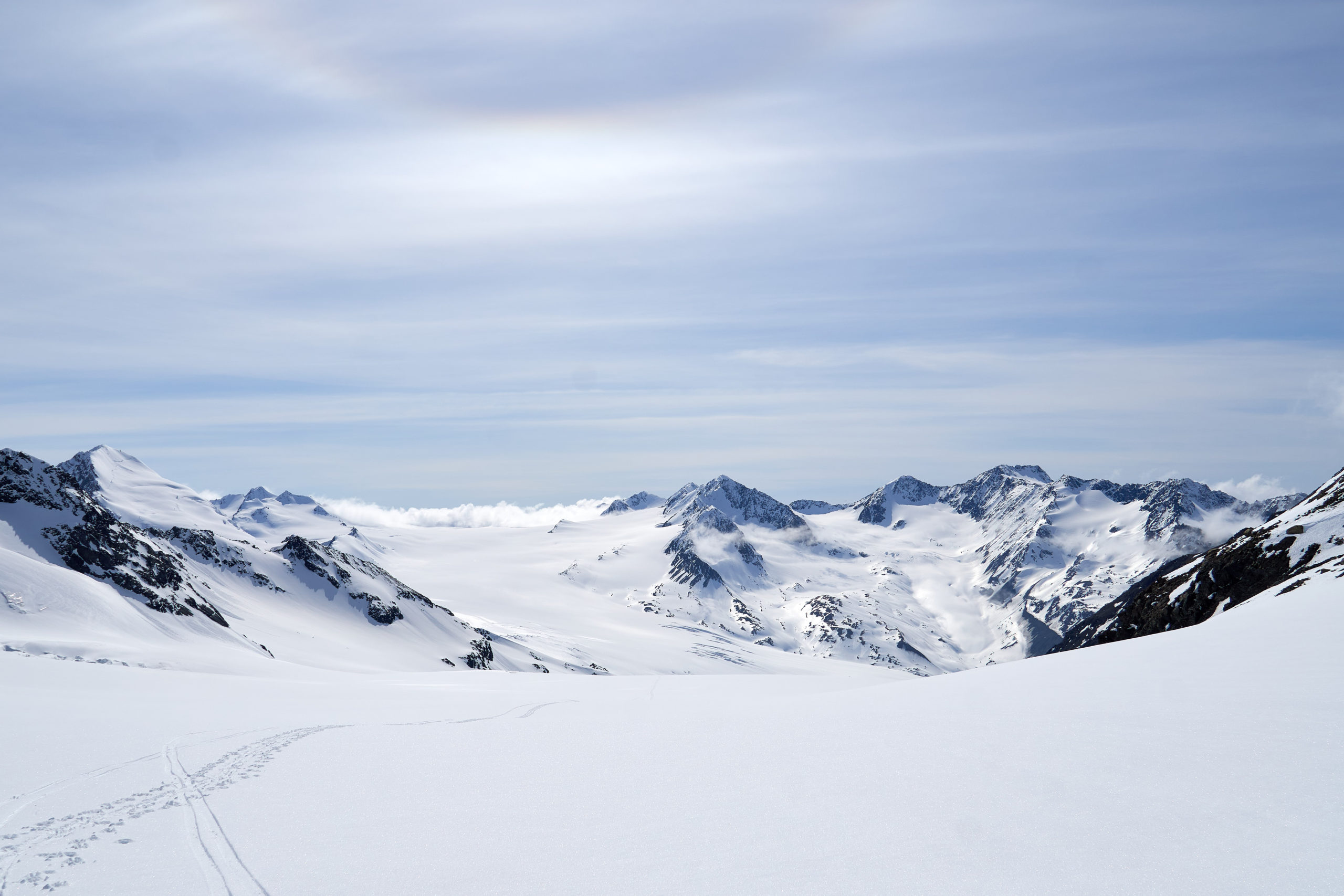
The descent down to Eagle Glacier is the most sustained glacial descent on the route, and correspondingly the most prone to crevasses. Spying some large crevasses lower on the descent we opted to ski down roped up, my first time ever doing that. It wasn’t the most graceful, but a team of two kept things reasonable and we were able to pick our way down without any major crashes. After 16 miles of walking it mainly just felt good to let gravity do some of the work.
We stuck to the skiers left side of the glacier and didn’t encounter any notable crevasses. Eventually we were able to cut left off the edge of the glacier onto a small ridge where we stopped to unrope so we could enjoy the rest of the descent.
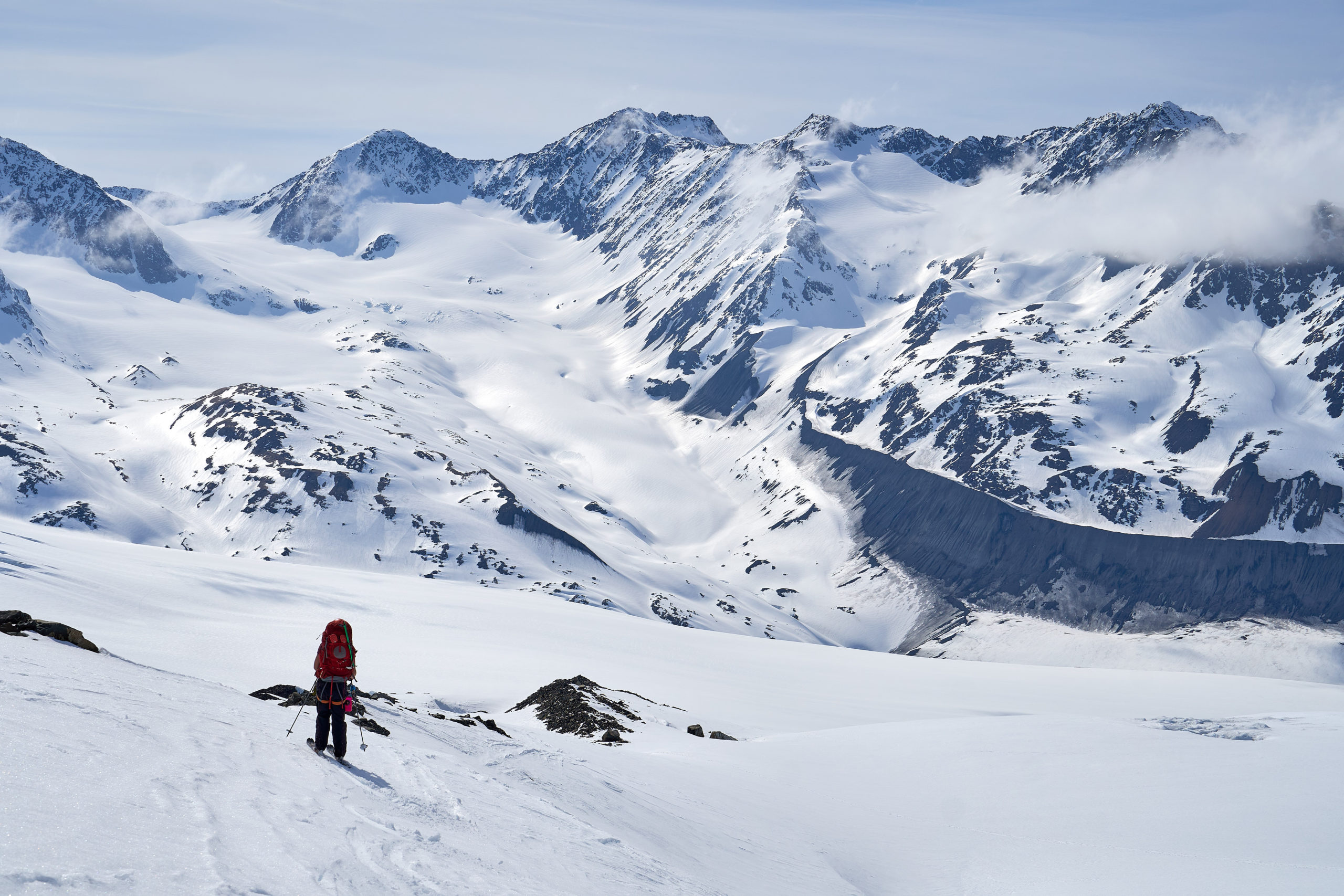
As we descended further down the ridge the previously supportive snow became more and more rotten. By the time we reached the edge of Eagle Glacier we were occasionally sinking in to our shins even with skis on. This was not good news. While most of the Eklutna Traverse is safe from avalanche terrain, the standard exit requires descending Raven Headwall, a short but very steep pitch of snow, and then out Crow Pass trail, a steep valley lined with overhead hazards. Since we had observed supportive snow for most of the day our hope had been that higher elevations were still seeing a solid refreeze at night and that with an early start we could be out before the snow warmed too much. The rotten snow we had just descended suggested we were being too optimistic and left the feasibility of our plan in question.
When we pulled out our phones to look at our maps we noticed that by some miracle we had a bit of service. We pulled up the avy forecast and much to our dismay saw a wall of bright red, high avy danger. Reading the report it became clear that the Chugach had started to see above-freezing nights and it was only a matter of time until it all came crashing down. In a final blow to our planned exit strategy, the avy report warned that even hikers should be aware of overhead hazards and called out the Crow Pass trail as an example of a trail to be careful of.
With the Raven Glacier exit looking like a no-go we did our best to calm our nerves. It was 5pm in the afternoon and we were 30+ miles of glaciated terrain from our car. Although we had plenty of food, it was hard not to feel a bit exposed.
One remaining option was exiting via Goat Ridge. While the standard route takes you out Raven Glacier, we had read reports of people descending off the 6000 foot south ridge of Goat Mountain. The obvious benefit of this option was being able to stick to a ridge rather than being trapped in a massive valley. But as we looked more closely at our maps we had serious doubts. Slope-shading showed blotches of steep terrain throughout the ridge and the route was entirely unknown to us. Just trying to figure out where we would get onto the ridge, either from the summit of Goat Mountain or the edge of Eagle Glacier seemed uncertain. To top it off, it would be extremely committing decision to try to descend the ridge. With continually warming weather we knew the massive south faces that the ridge splits would be death traps for the foreseeable future. If we got partway down the ridge and then found it unsafe to continue we would have no option but to climb all the way back out and reverse the entire traverse.
To help make the decision we decided to take advantage of the service and phone our friend Pete, a Chugach local and all-around badass. Luckily Pete picked up and Taryn proceeded to grill him with questions. I could tell from her facial expressions that she wasn’t getting the news she wanted. Hanging up she reported that Pete had largely confirmed our assessment. He warned that the route finding on the ridge could be quite complex and that sections of it might be exposed to avalanche hazard. He did kindly offer to fly his bush plane over the area if he didn’t hear from us in a couple days.
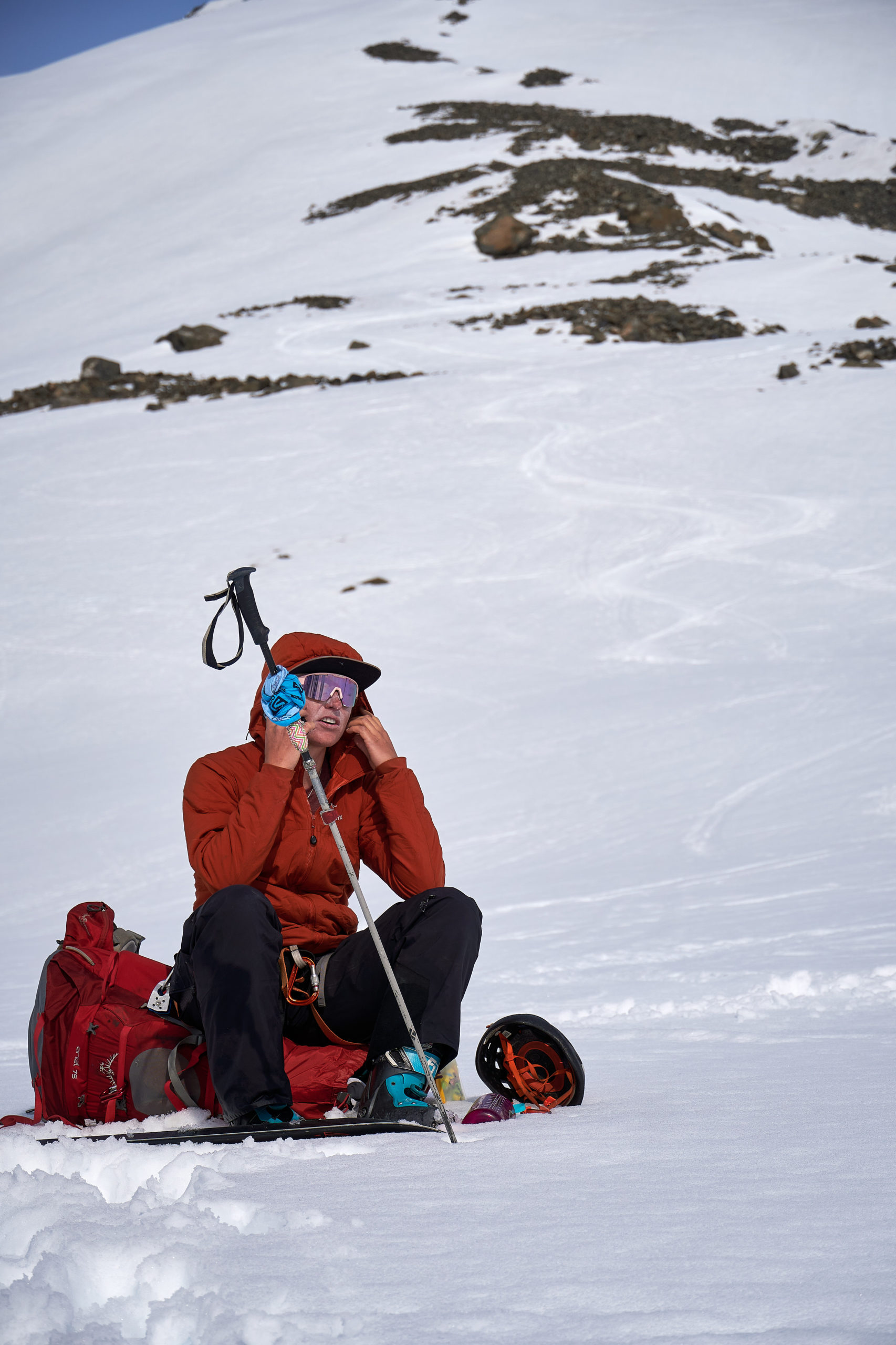
With all other exits blocked we steeled ourselves for the only safe option, retracing all of our steps back out to Eklutna Lake. We figured if we climbed the 2500 feet back up to Han’s Hut in the evening, we could wake up super early and still make sure we were out of the mountains before it got too warm the following day. Rosie’s Roost looked tantalizing close (visible on the moraine in the photo below), but we turned our attention back to the slope we had just descended and started slowly plodding our way back up.
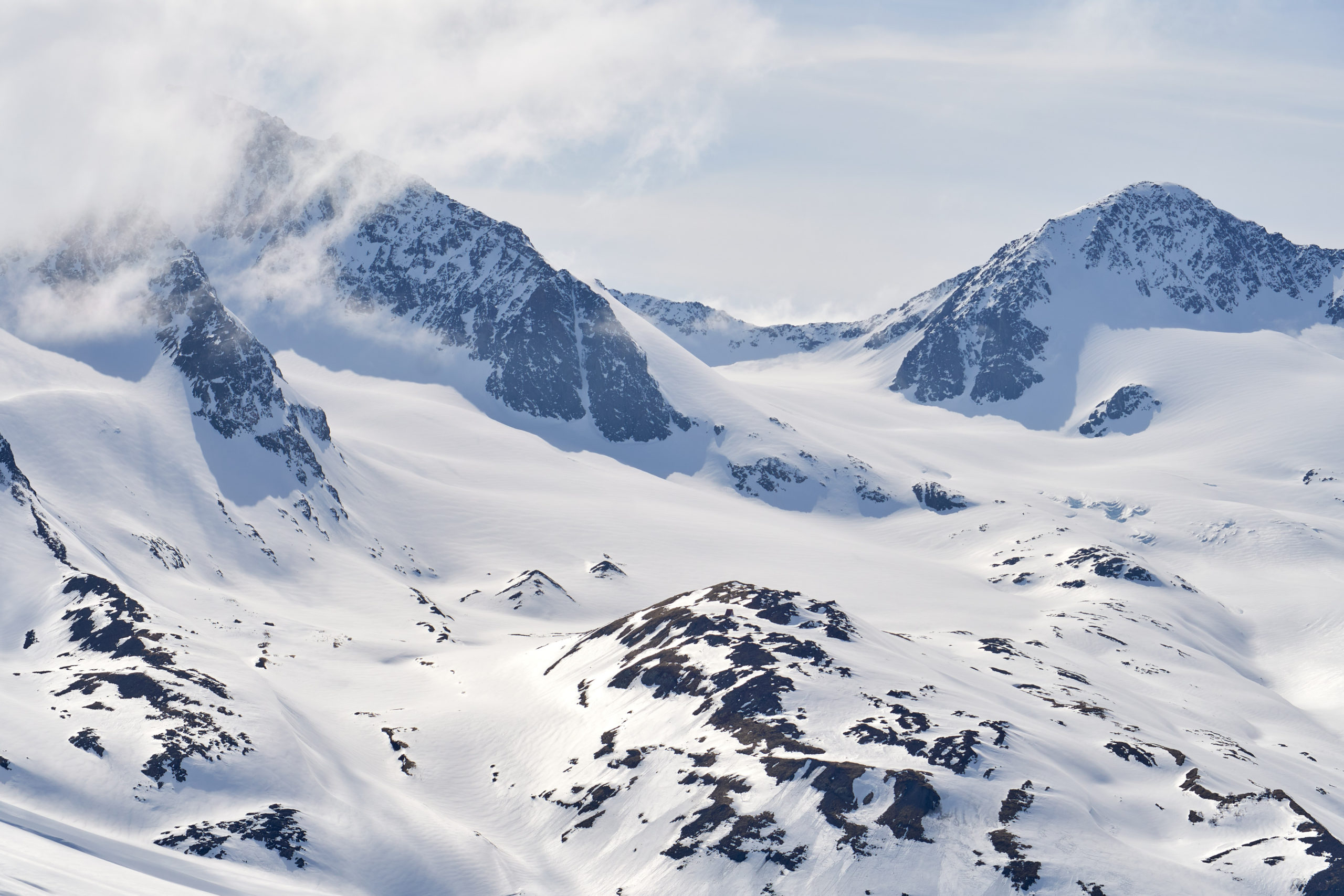
The slog back to Han’s Hut as as brutal as we had expected. We baked under the afternoon sun as we dragged our skis through slushy snow. We spoke occasionally, at times to lament our sore feet, at times to express gratitude that our bodies were able to carry us out of the unsafe situation we had put ourselves in. But mostly we just walked in silence, dreaming about what it would feel like to take off our boots and eat a warm dinner.
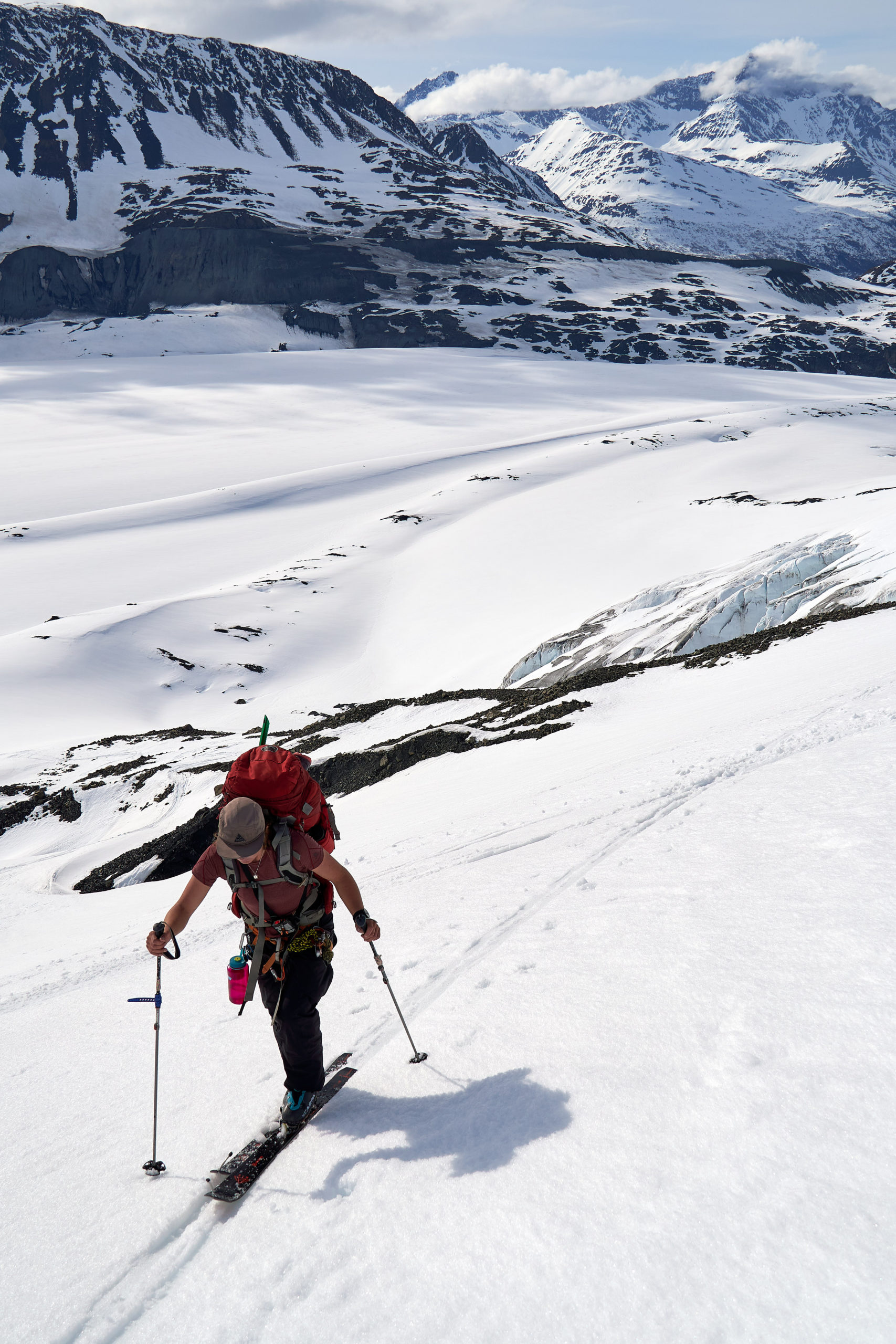
After two hours of climbing Han’s Hut again came into view perched above the glacier on its little bench.
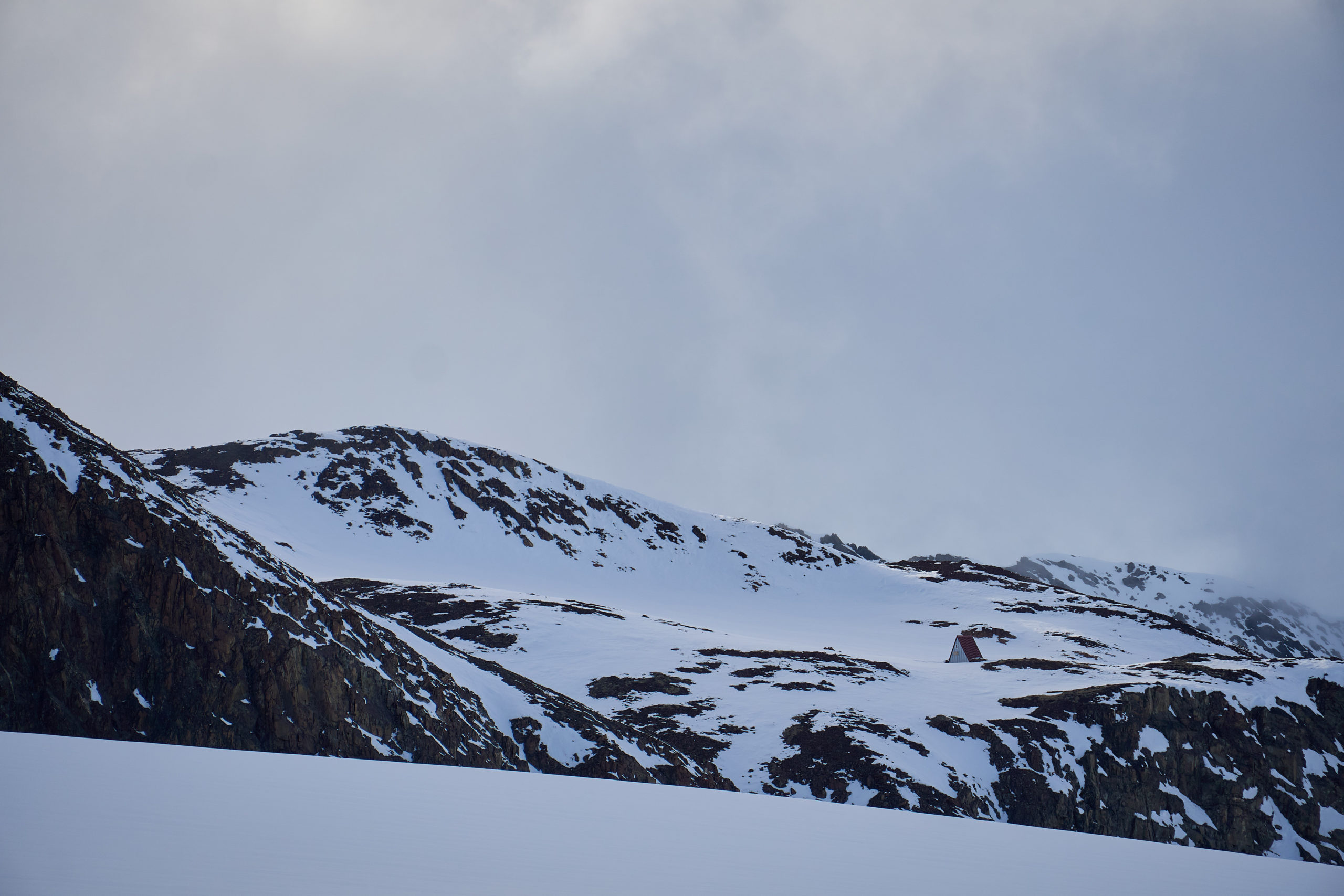
The final skin up the slope to the hut felt endless, but finally we arrived at Han’s Hut, so relieved to be done for the day. It had been twelve and half hours since we had left Serenity Falls and the day had been a roller coaster of experiences, from mind-numbing monotony to outrageous grandeur, at times feeling very small and at times feeling very capable.
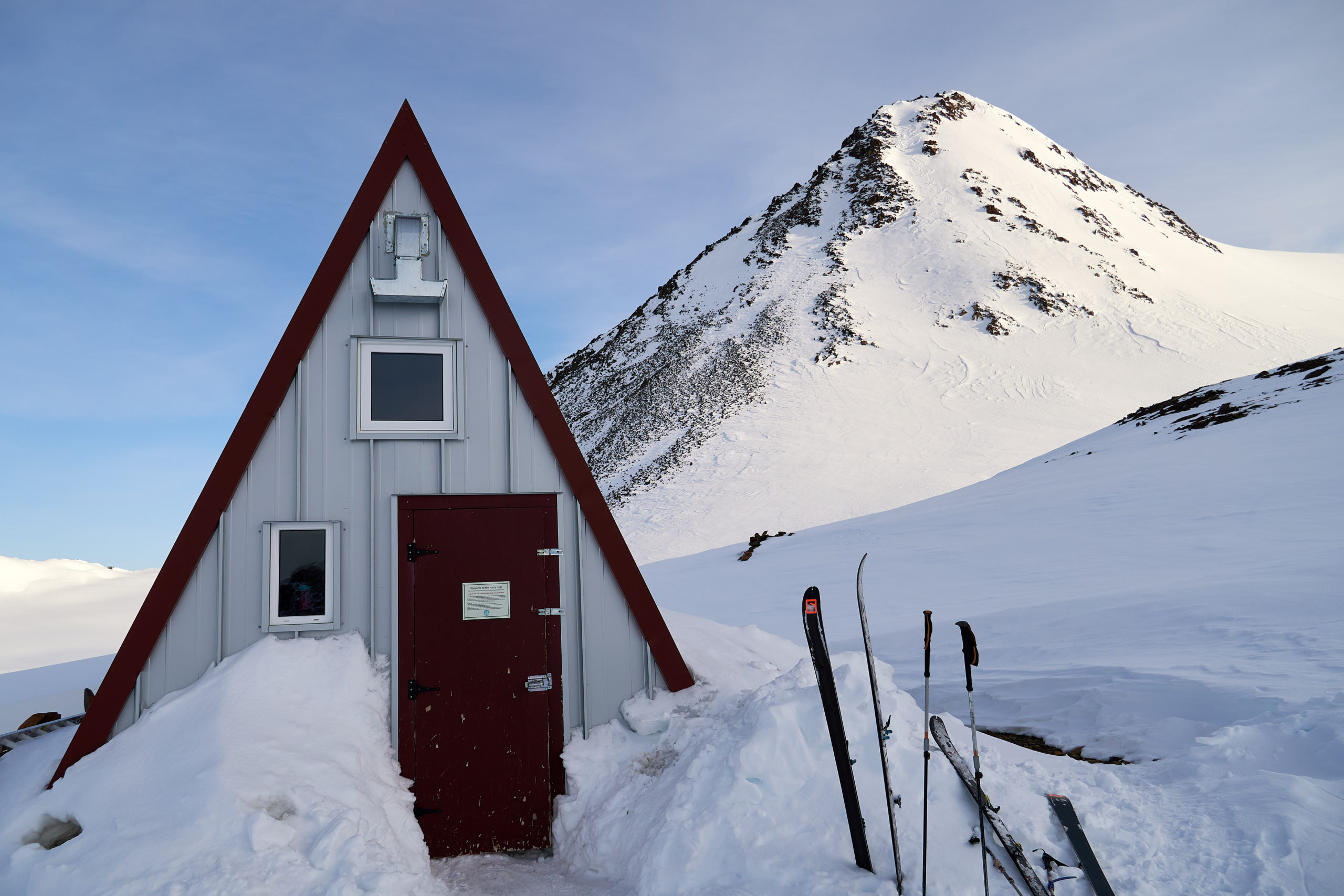
We set about boiling some water and making some dinner. As we sipped some warm tea we were finally able to really relax and appreciate the landscape we found ourselves in. The evening light slid over the vast wilderness, illuminating distant peaks and reminding us how lucky we were to be spending a night in such a beautiful spot.
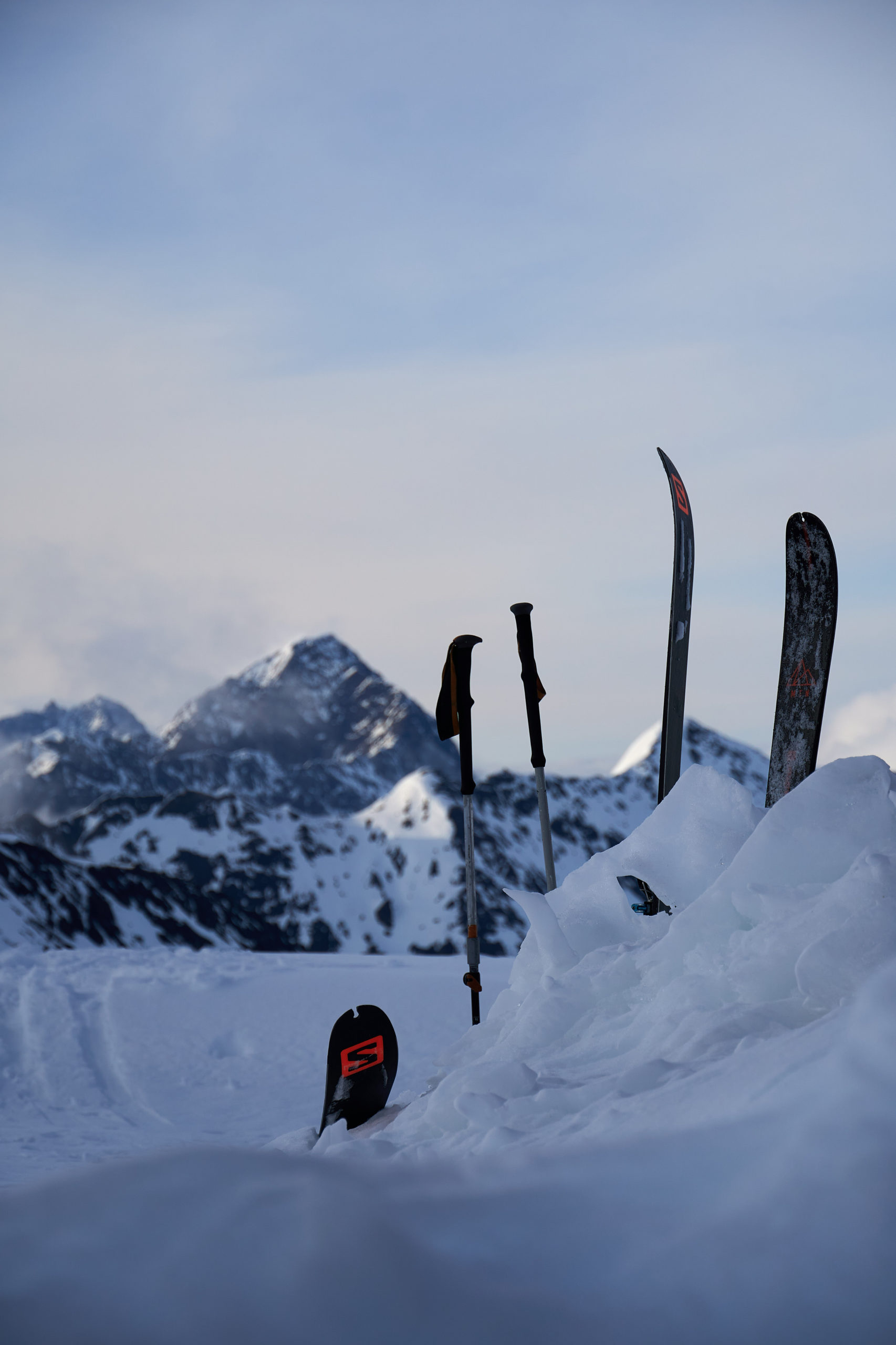
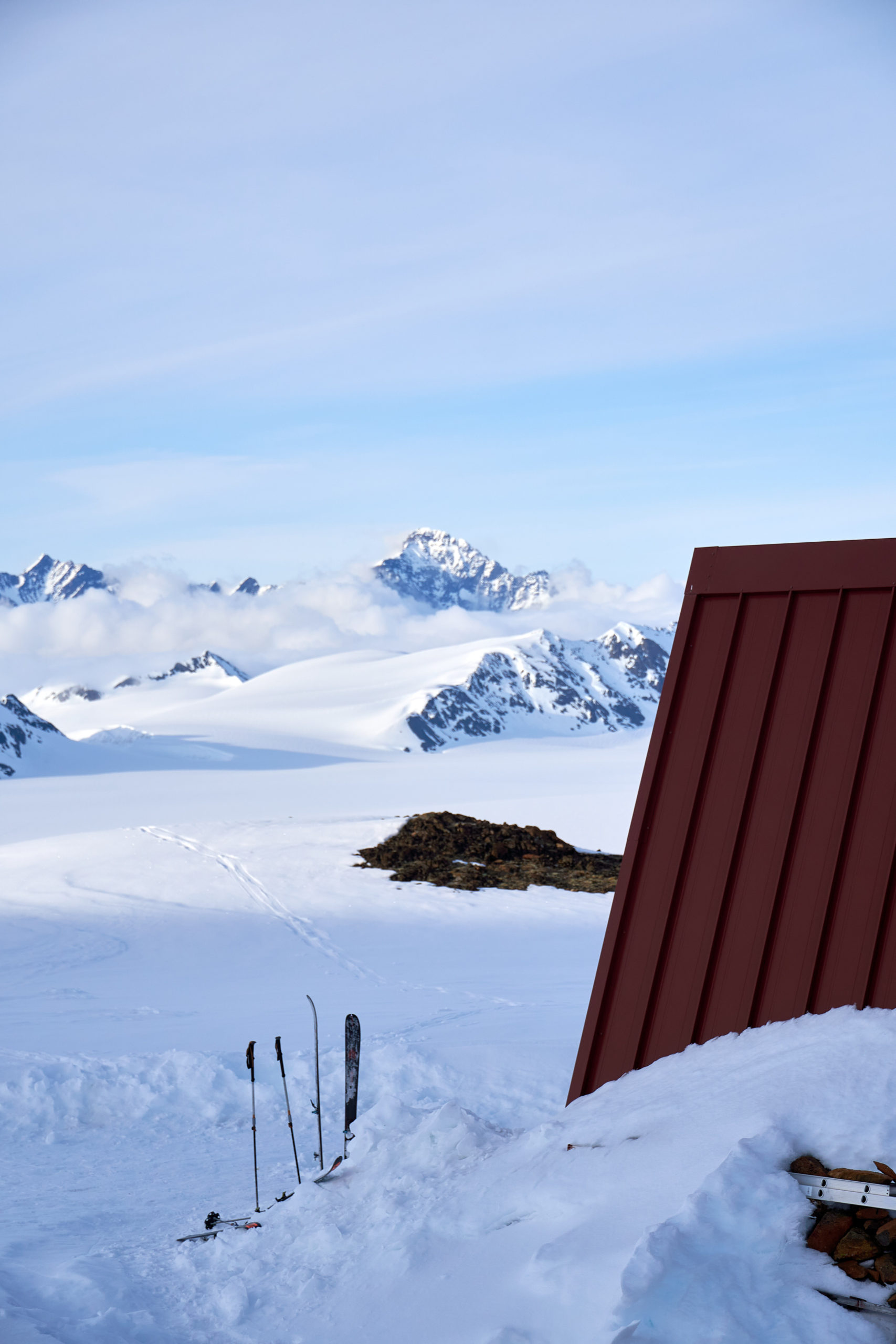
Eventually the sun disappeared behind the horizon and we climbed up into the loft and snuggled into our warm sleeping bags, exhausted but content.
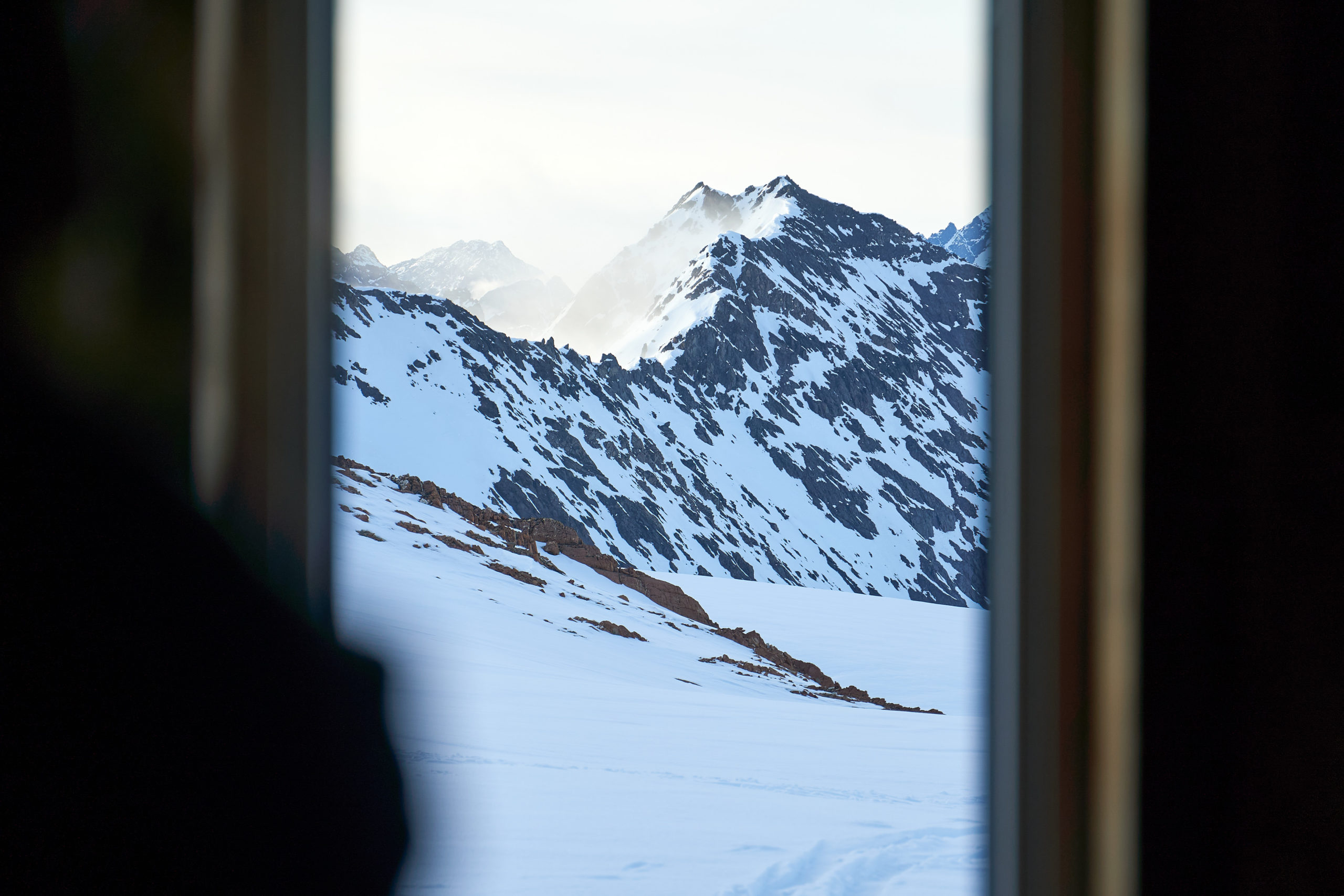
At 5:30am we awoke, groggy, to our alarms. We forced down some oatmeal, gave the hut a quick tidy, and forced our sore feet back into ski boots. We shouldered our packs and stepped out into the crisp morning air, the first morning rays just starting to light up the sky.
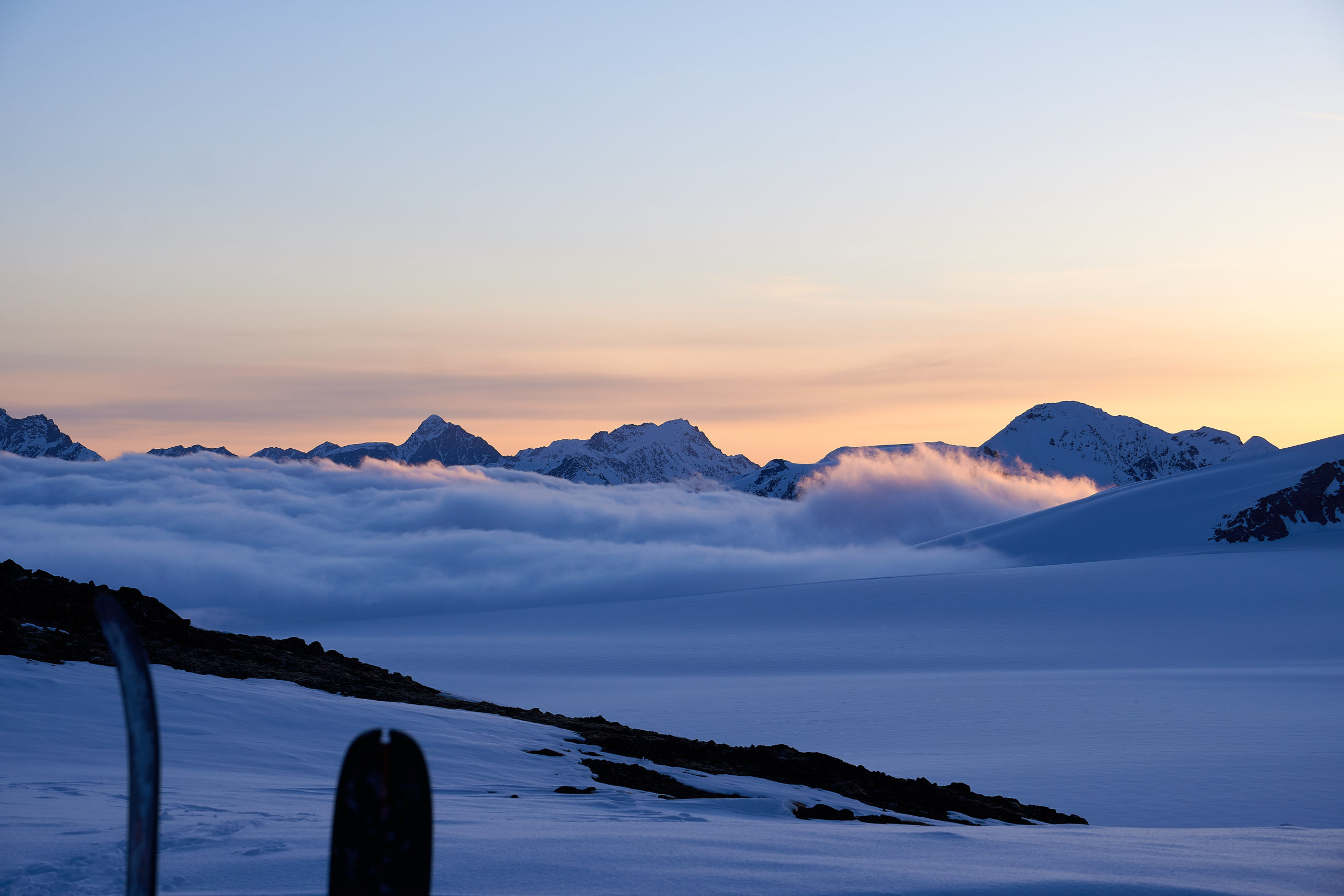
The clouds had once again settled over Whiteout Glacier and began to be illuminated by the morning sun, forming a beautiful sea of of deep blues and gentle pinks.
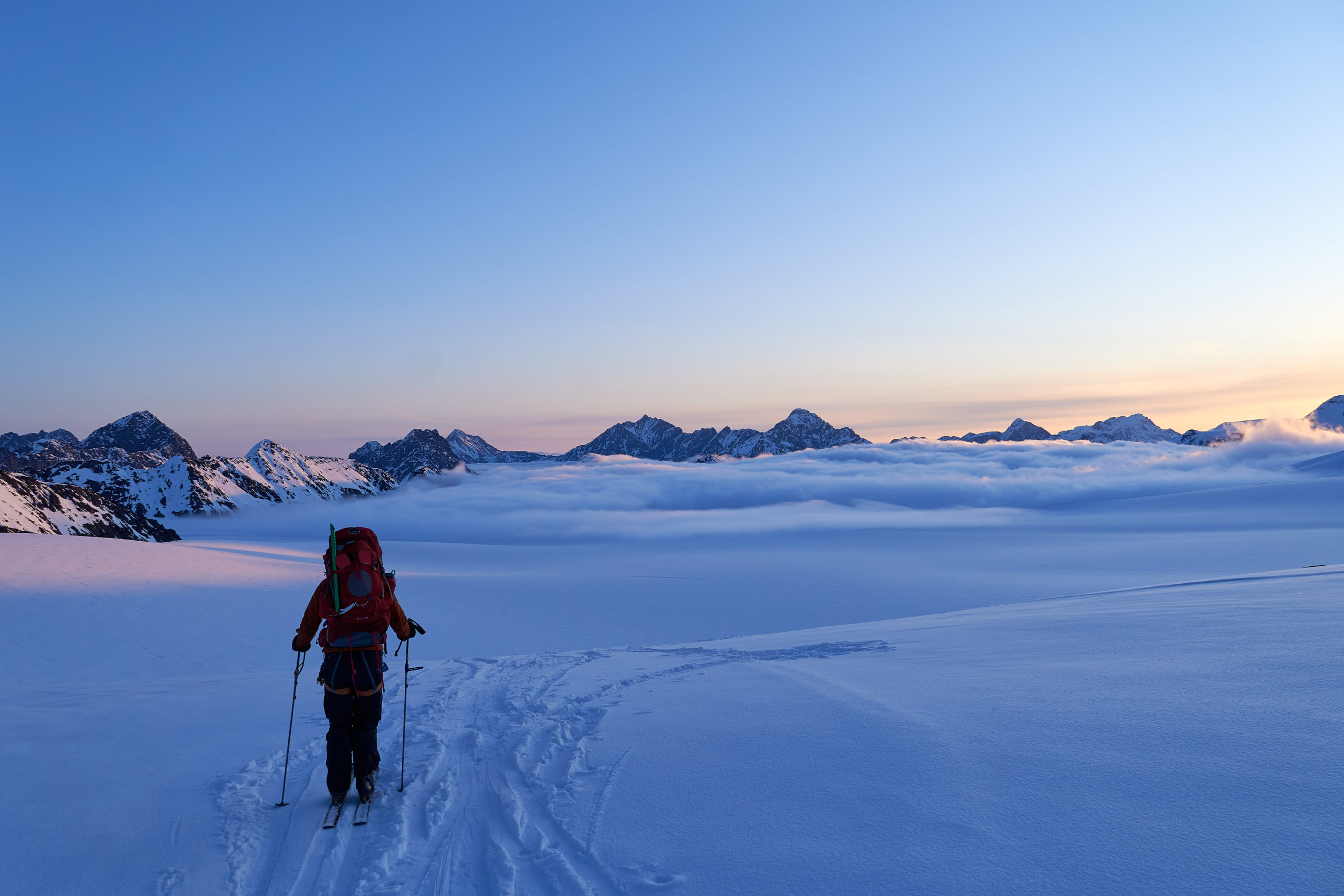
The descent off the bench down to the glacier was utterly blissful. The snow was excellent, the wind non-existent, and the backdrop as grand as it gets.
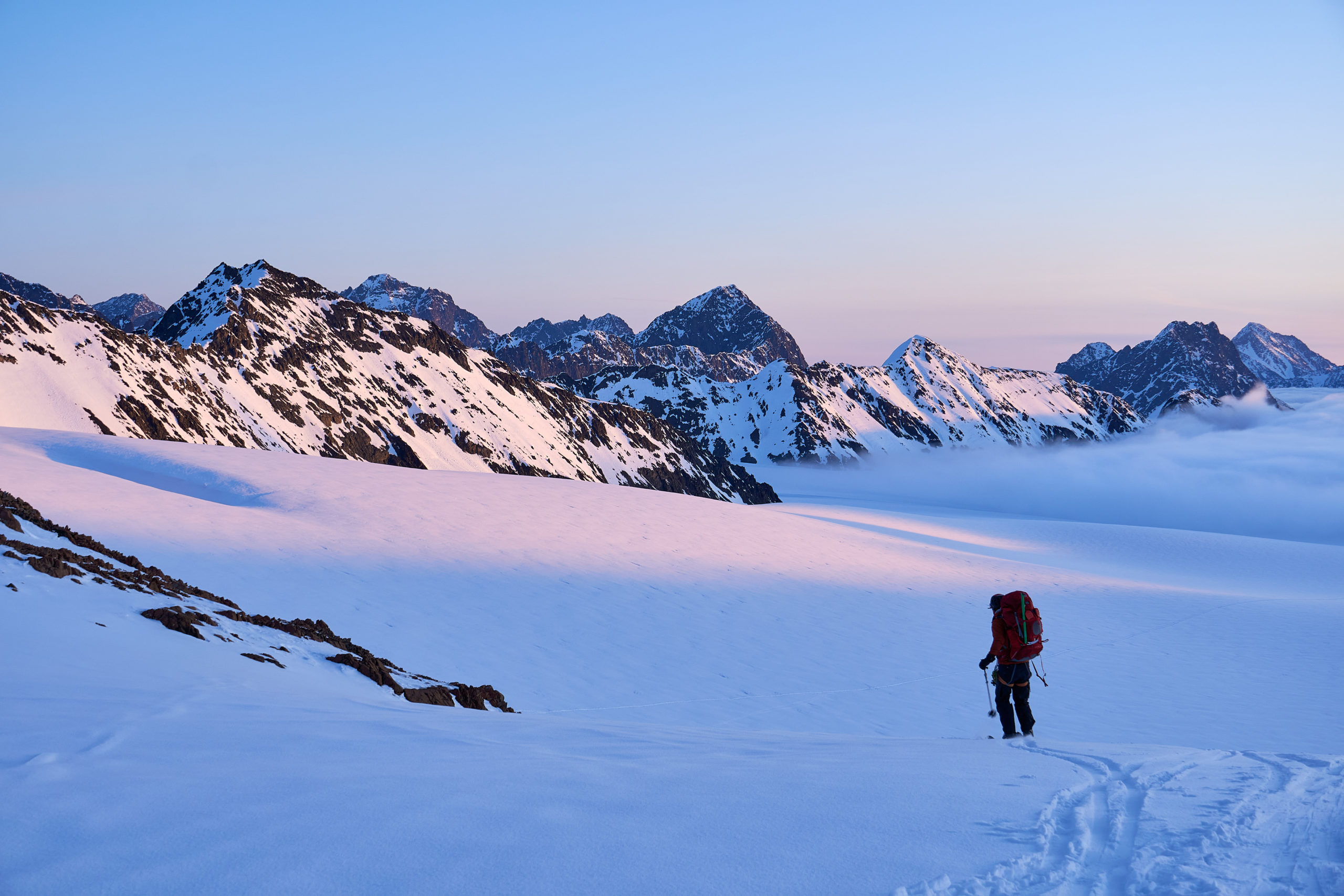
I hung back to take some pictures, marveling as Taryn’s distant outline provided a singular point of scale in the otherwise scale-less landscape. Taryn soon approached the wall of cotton-candy clouds and I hurried to catch up so we could traverse through the whiteout together.
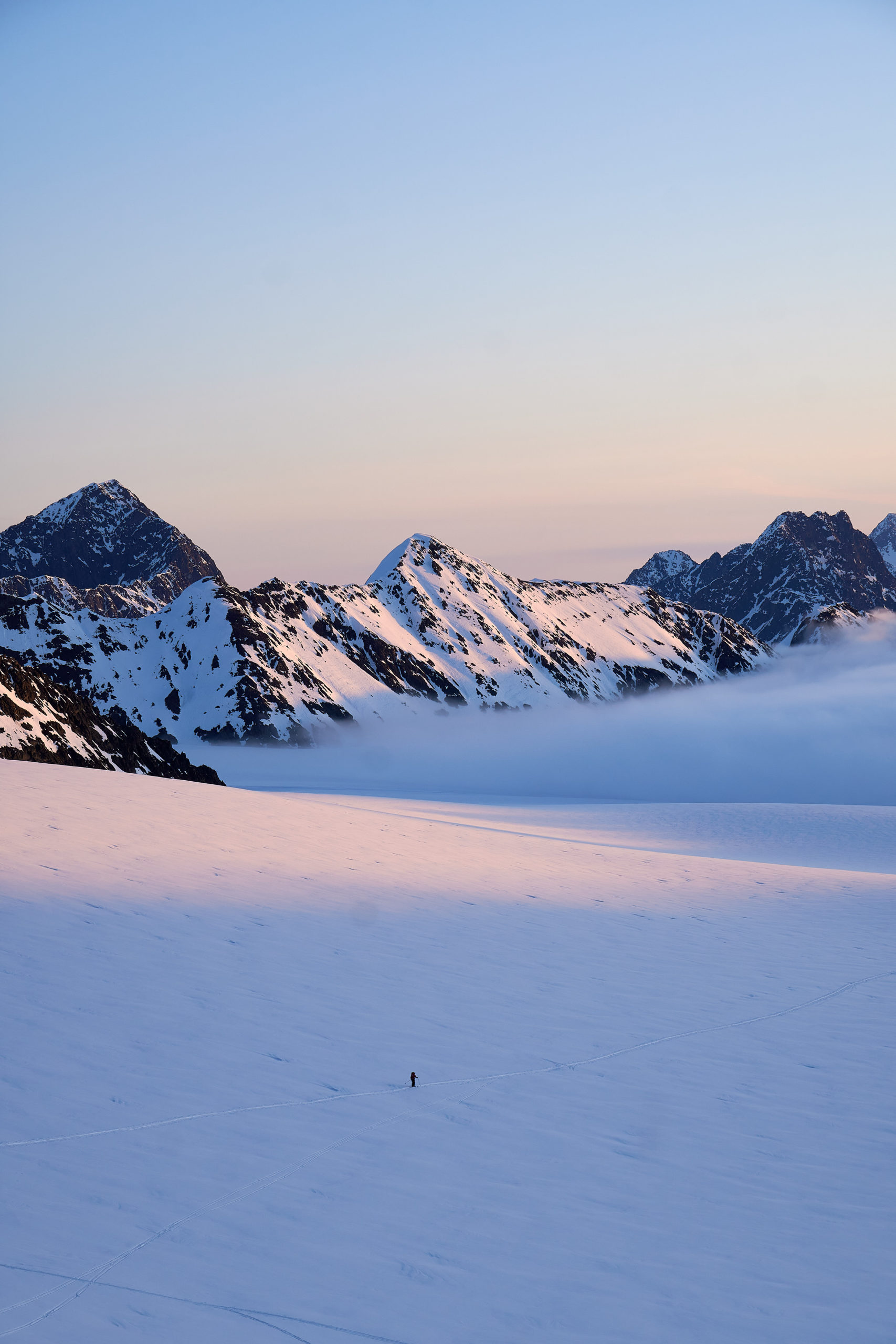


Our previous day’s skin track made for simple navigation and we found ourselves pleasantly surprised by the ease of travel. The slight uphill had been almost imperceptible the day prior, but now with the firm morning snow we found ourselves largely gliding along, with only the occasional double-poling or skating needed.
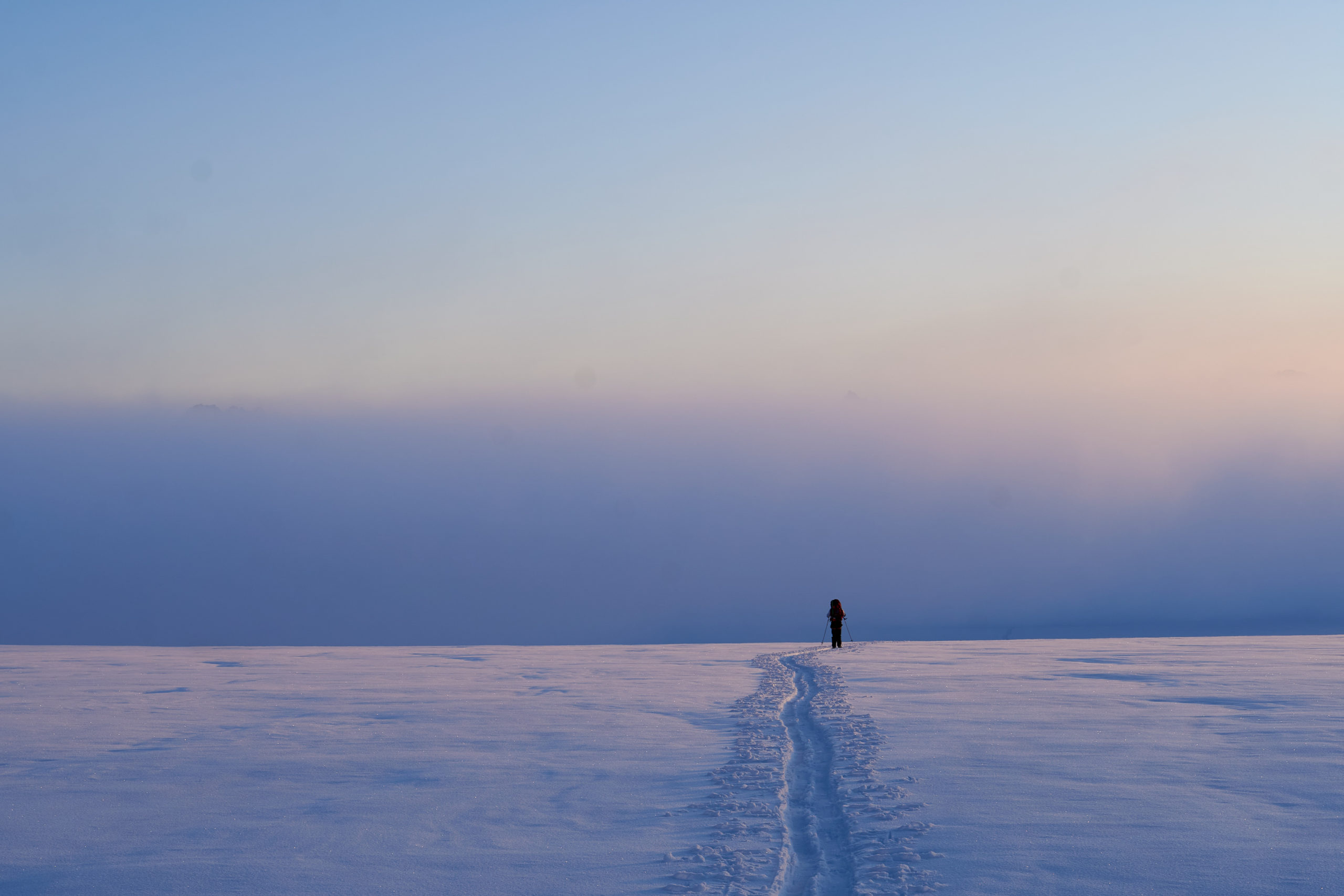
It took only 45 minutes to reach Whiteout Pass and then only another 30 to reach the final descent down off Eklutna Glacier. We were overjoyed. The previous day we had mentally prepared ourselves to have to skin the whole way back to Serenity Falls, but it was only 7:30am and we were almost off the glaciers! We were all smiles as we party skied down the final slope down to the toe of the glacier.
From the toe of the glacier it was just a simple matter of retracing our route from the prior day. The snow grew softer and more rotten as we worked our way down, but we navigated the few steep slopes safely.
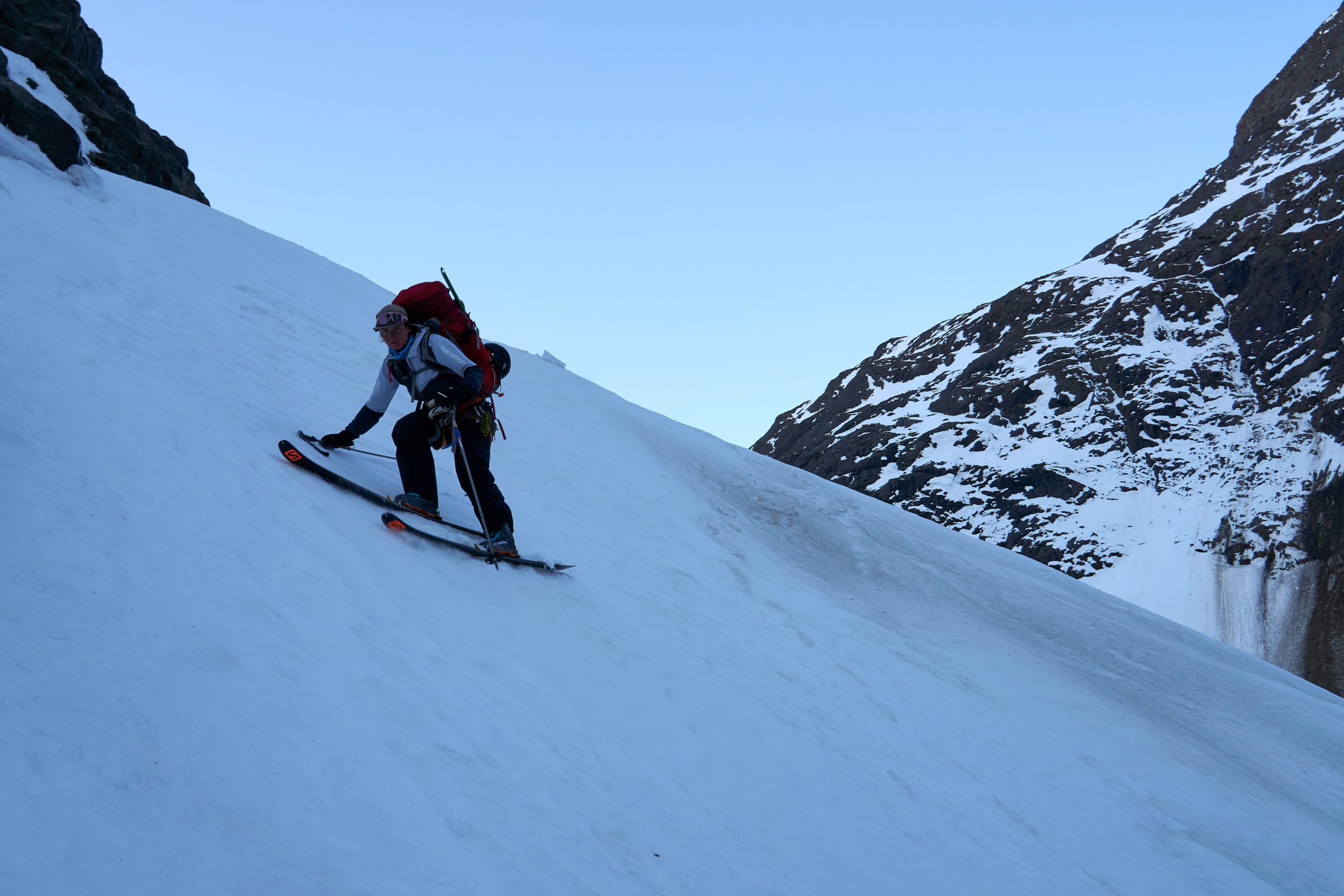
Reaching flat ground beneath the glacier I felt that familiar lightness feeling I get when finishing with the objective hazards for the trip. We milked the last remaining snow and then transitioned to our shoes, done with the ski portion of the adventure.
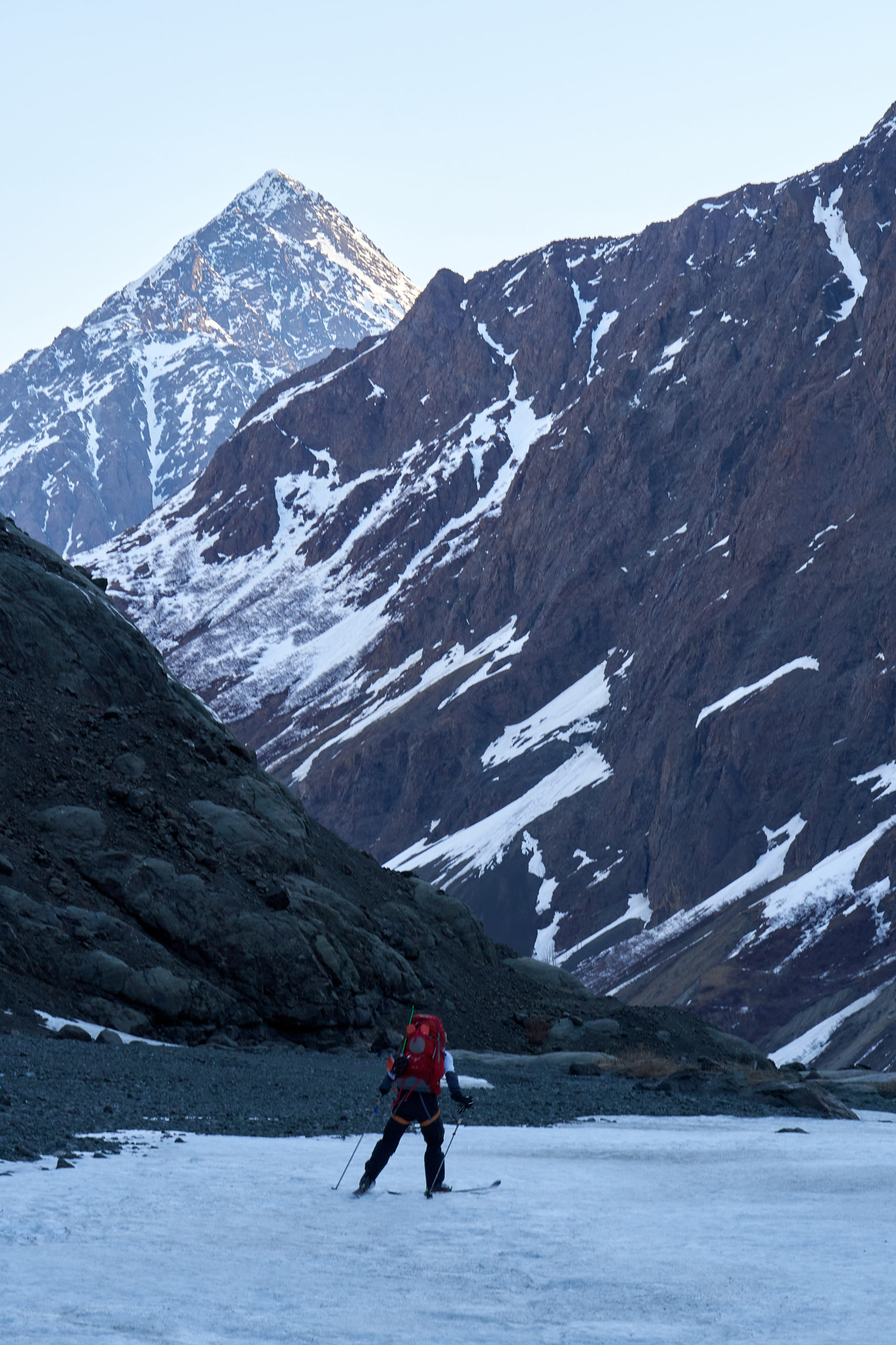
From there it was just a nice 12 mile walk back around the lake. The walk felt even more tedious than on the way in and we tried to stay sane as we advanced comically slowly around the lake. Any doubts about our decisions were destroyed instantly, however, when we saw a large wet avalanche rip on the east face of a nearby peak. Seeing the debris pour over a lower cliff band I could feel nothing but gratitude that we were not on some unknown ridge or steep-walled valley at the moment, and were instead enjoying a civilized springtime stroll back to our car.
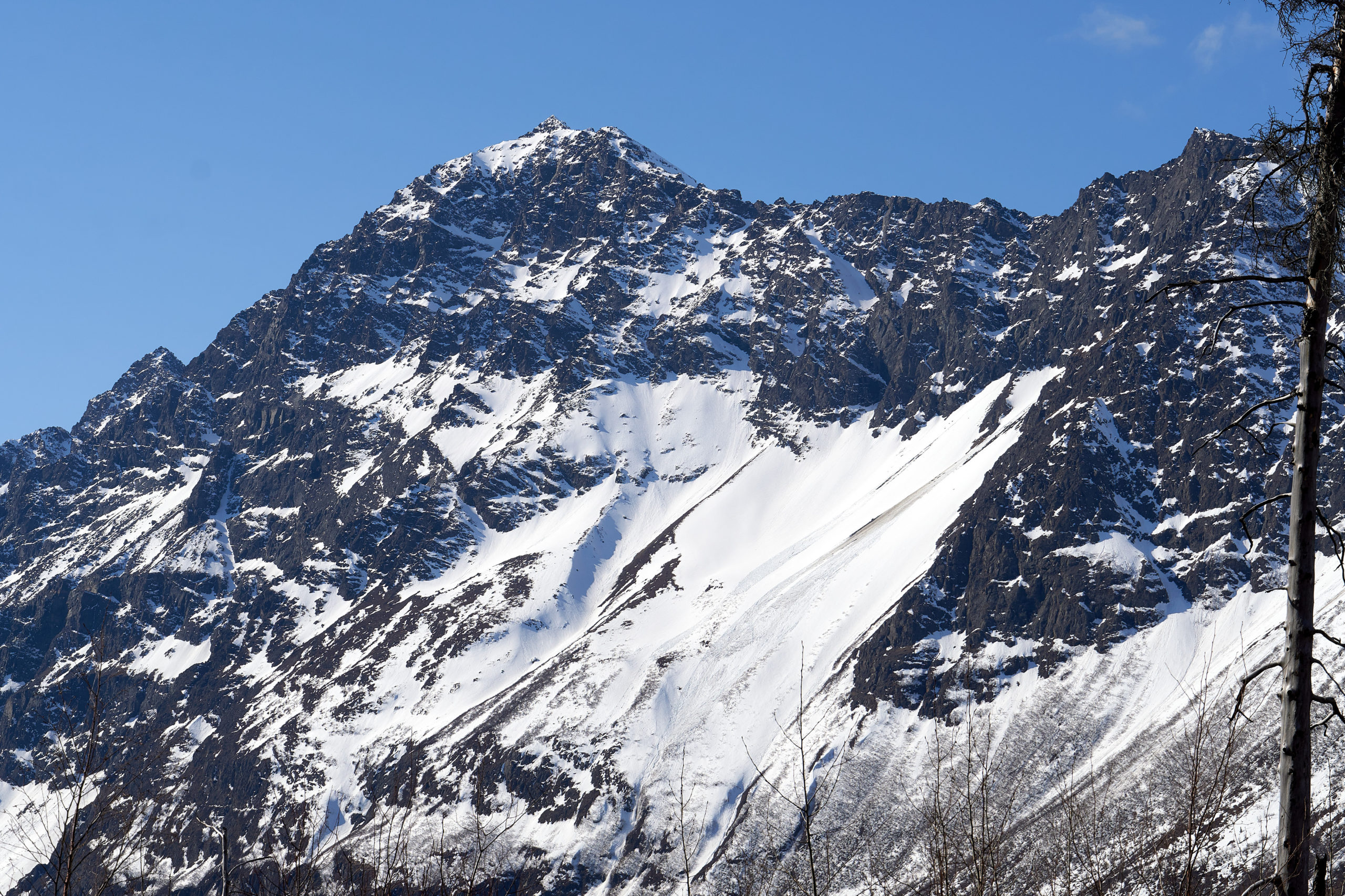
We reached our car a little after 2pm, less than 48 hours after leaving on the adventure. Even more remarkable, we realized it had been just under a week since we had left San Francisco on our way to Mt. Shasta, a journey that had taken us through four states and across nearly 100 miles of beautiful mountainous terrain. What a whirlwind!
Despite not finishing off the traverse (and the associated suffering that came with having to retrace our steps), the Eklutna Traverse ended up being one of my favorite adventures from the spring. I’m proud of the decisions Taryn and I made along the way and I’m proud of my body for being able to support those decisions and get me where I needed to go. The scale and solitude of Alaska is truly unique and the sunrise from Han’s Hut is one I won’t soon forget. The traverse was the culmination of a week of going with the flow, and all the beauty we got to experience along the way is a lesson I will remember going forward.
Leave a Reply